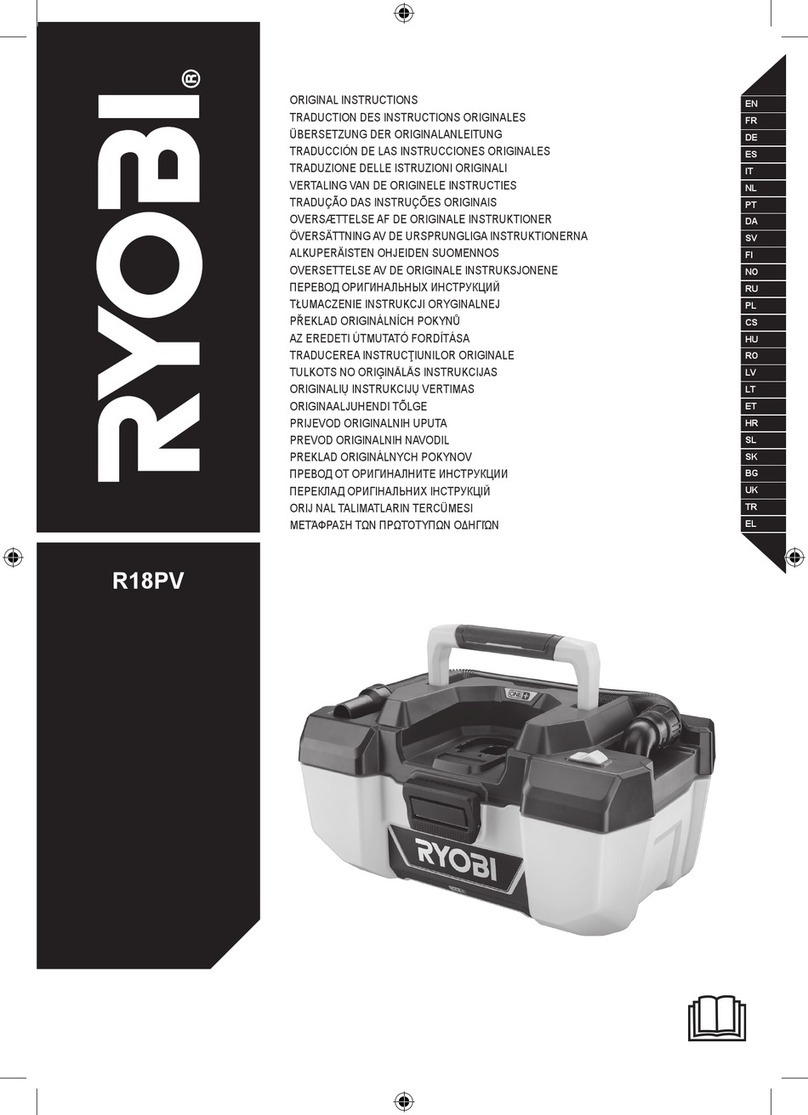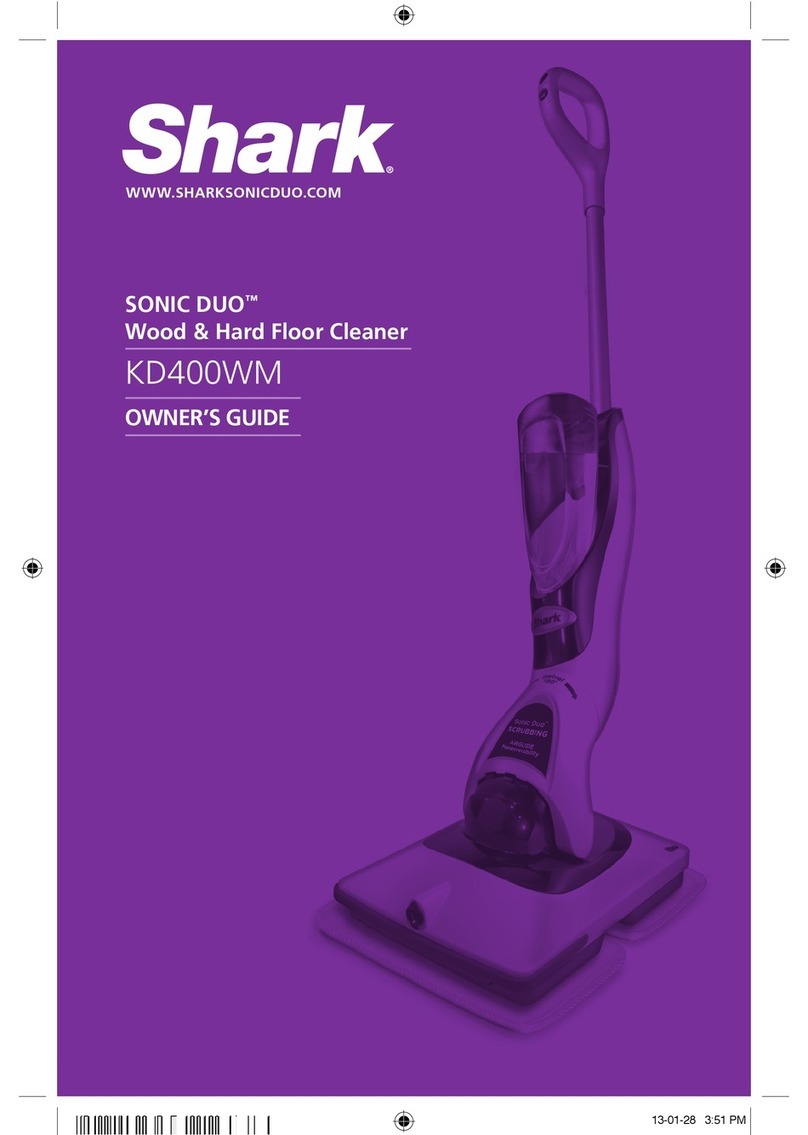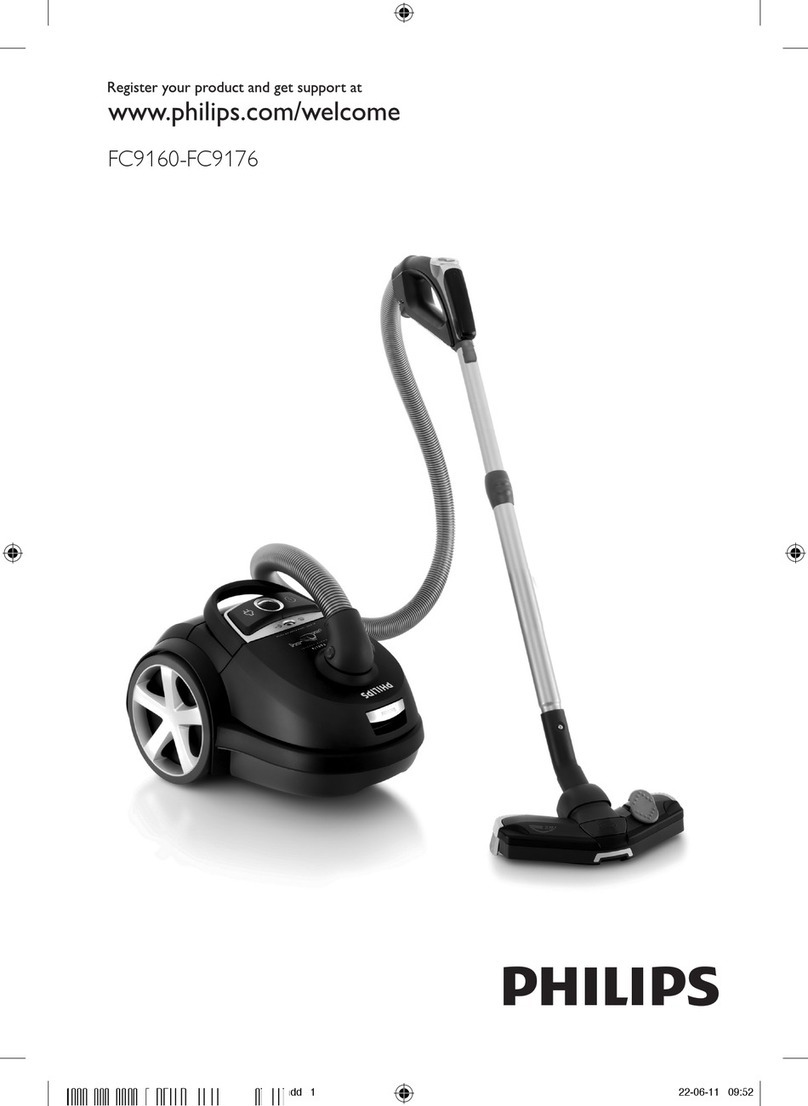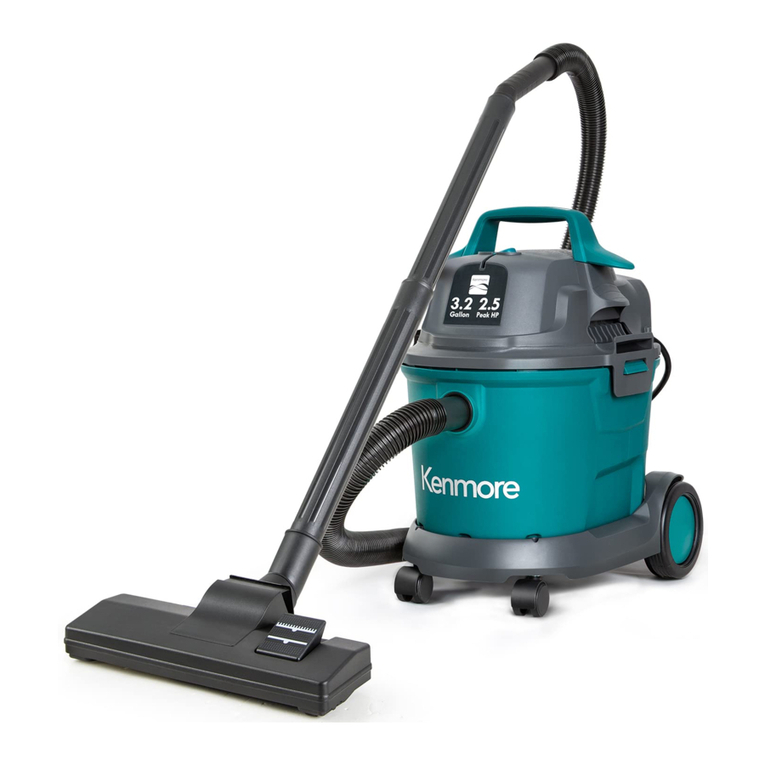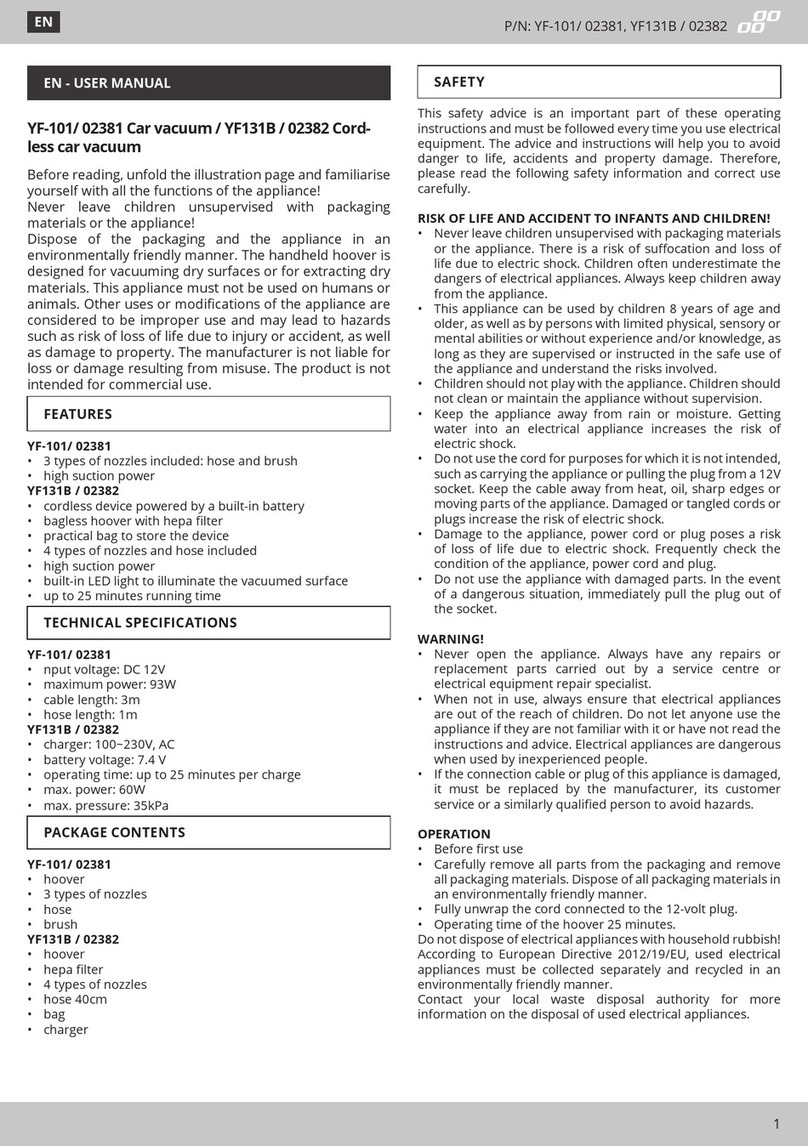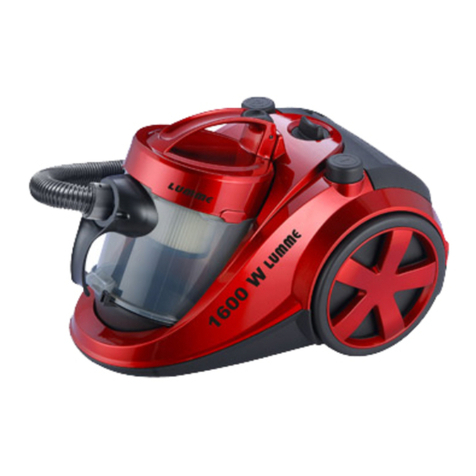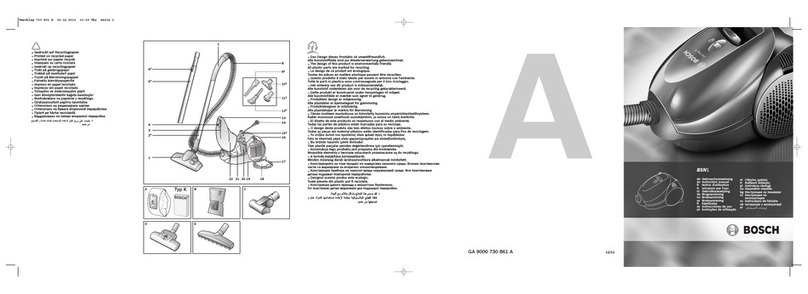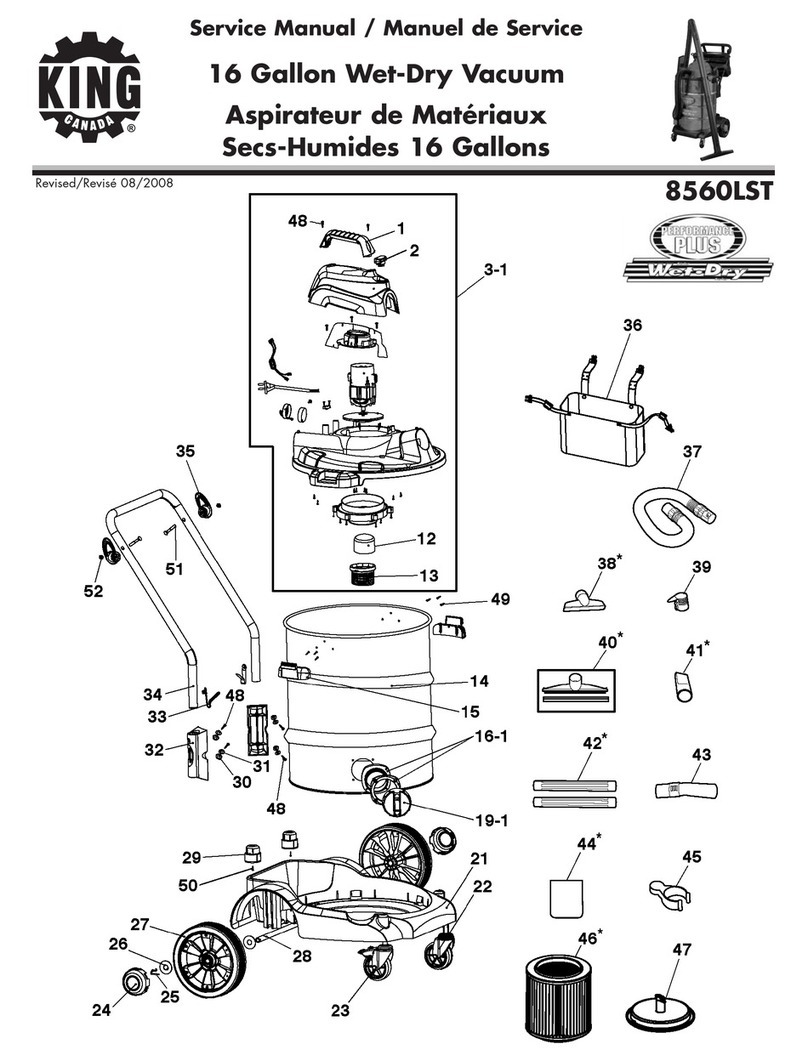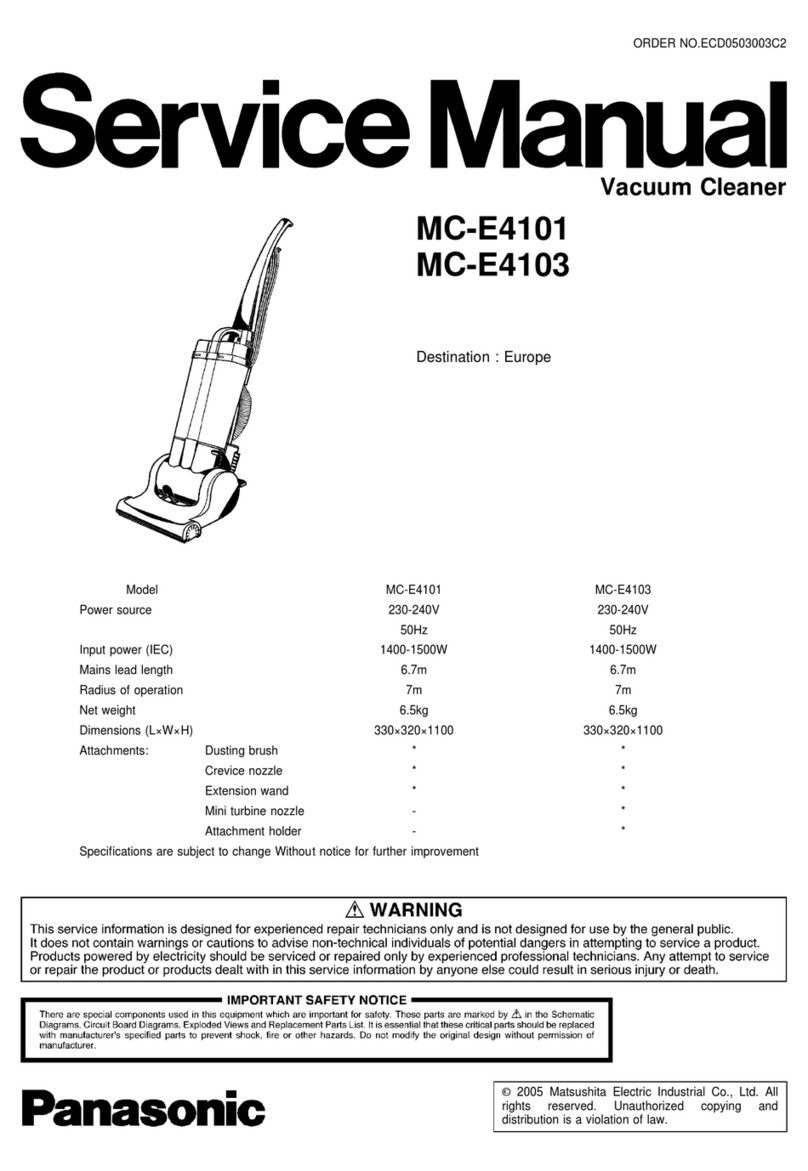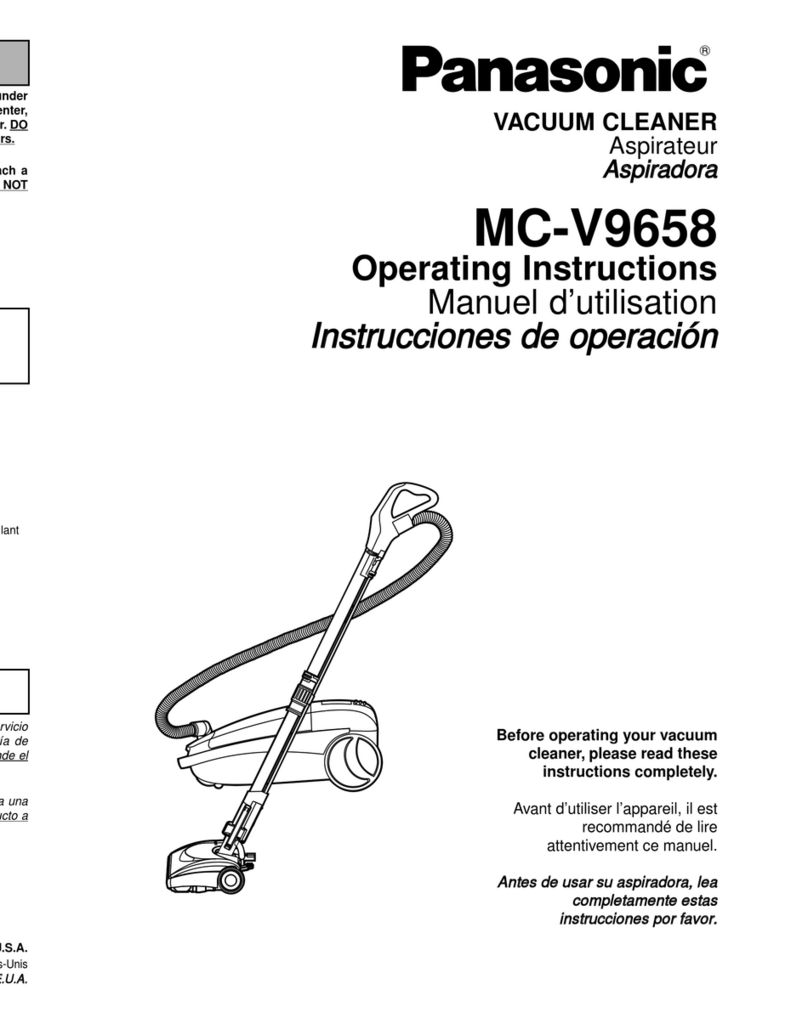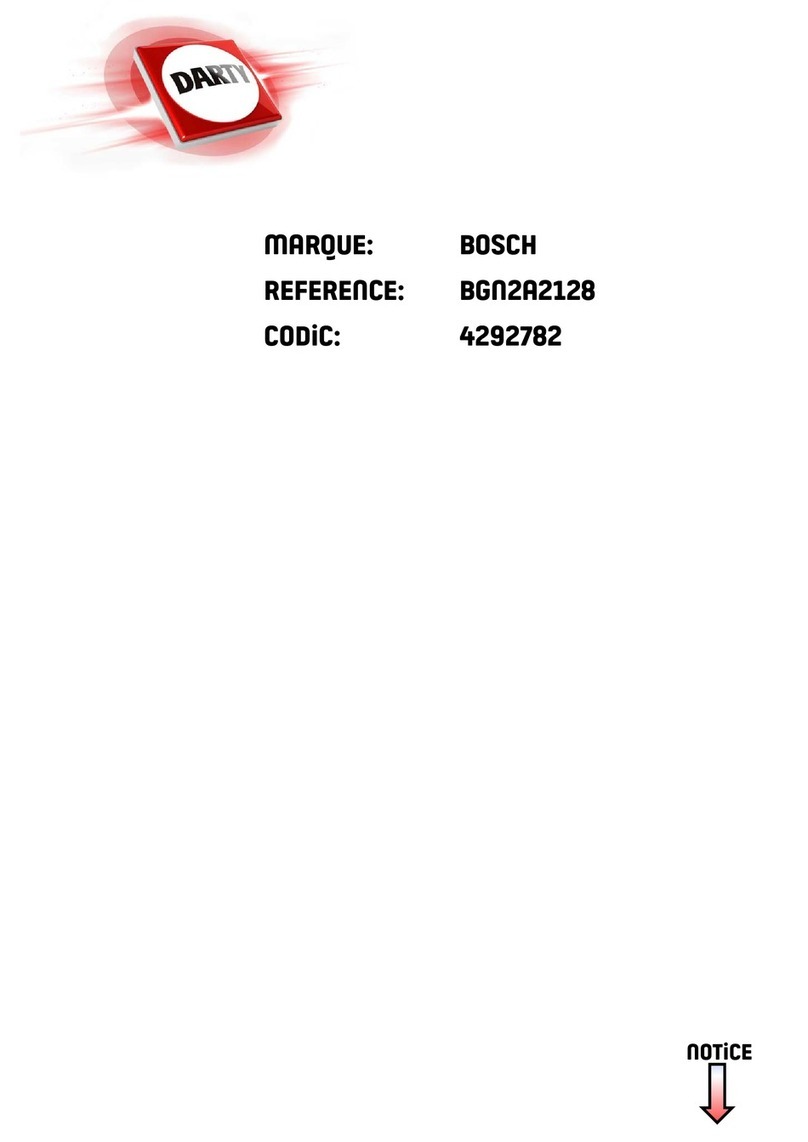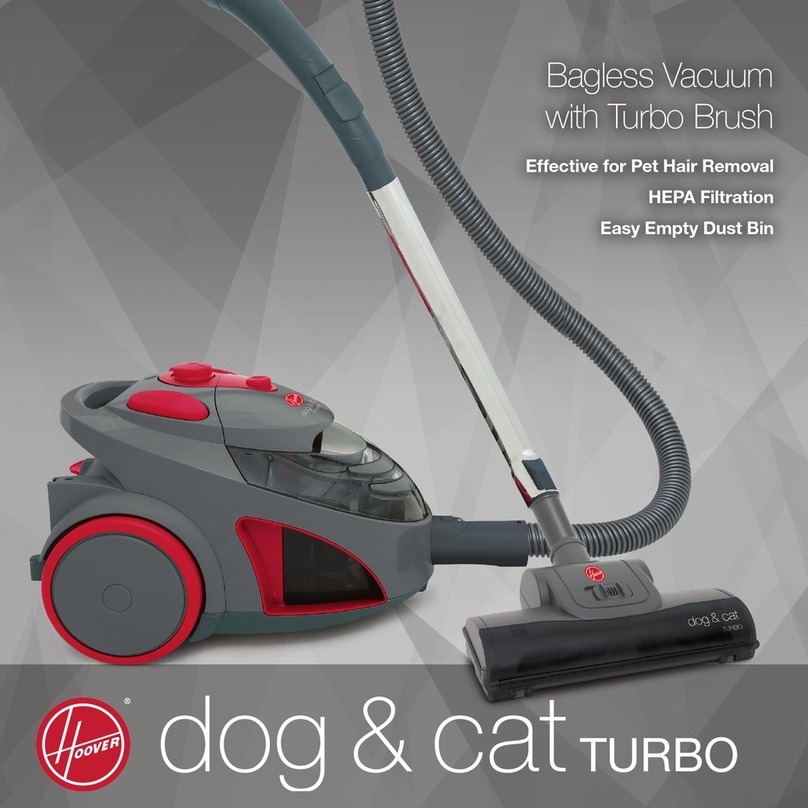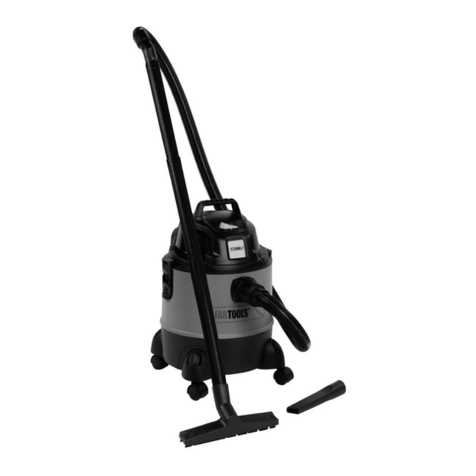Ryobi TC400 User manual

OPERATOR’S MANUAL
MANUEL D’UTILISATION
MANUAL DEL OPERADOR
4 in. WET/DRY TILE SAW
SCIE À CARREAUX À SEC/SOUS
EAU DE 101,6 mm (4 po)
SIERRA DE LOSAS PARA TRABAJOS
EN HÚMEDO/SECO de 101,6 mm (4 pulg.)
TC400
Cette scie à carreaux a été conçue et fabriquée conformément
à nos strictes normes de fiabilité, simplicité d’emploi et sécurité
d’utilisation. Correctement entretenue, elle vous donnera des an-
nées de fonctionnement robuste et sans problème.
AVERTISSEMENT : Pour réduire les risques de
blessures, l’utilisateur doit lire et veiller à bien comprendre le
manuel d’utilisation avant d’employer ce produit.
Merci de votre achat.
Su sierra de losas ha sido diseñado y fabricado de conformidad con
nuestras estrictas normas para brindar fiabilidad, facilidad de uso
y seguridad para el operador. Con el debido cuidado, le brindará
muchos años de sólido y eficiente funcionamiento.
ADVERTENCIA: Para reducir el riesgo de lesiones,
el usuario debe leer y comprender el manual del operador antes
de usar este producto.
Le agradecemos su compra.
CONSERVER CE MANUEL POUR
FUTURE RÉFÉRENCE GUARDE ESTE MANUAL PARA
FUTURAS CONSULTAS
SAVE THIS MANUAL FOR FUTURE REFERENCE
Your tile saw has been engineered and manufactured to our high standard for dependability, ease of operation, and operator
safety. When properly cared for, it will give you years of rugged, trouble-free performance.
WARNING: To reduce the risk of injury, the user must read and understand the operator’s manual before using
this product.
Thank you for your purchase.

2 — English
Introduction ..................................................................................................................................................................... 2
Warranty .......................................................................................................................................................................... 2
General Power Tool Safety Warnings ...........................................................................................................................3-4
Tile Saw Safety Warnings.............................................................................................................................................4-5
Symbols........................................................................................................................................................................... 6
Electrical.......................................................................................................................................................................7-8
Features........................................................................................................................................................................... 8
Assembly....................................................................................................................................................................9-10
Operation..................................................................................................................................................................10-12
Maintenance.................................................................................................................................................................. 13
Figure Numbers (Illustrations)................................................................................................................................... 14-16
Parts Ordering / Service ...................................................................................................................................Back Page
TABLE OF CONTENTS
INTRODUCTION
This product has many features for making its use more pleasant and enjoyable. Safety, performance, and dependability
have been given top priority in the design of this product making it easy to maintain and operate.
WARRANTY
RYOBI®POWER TOOL - LIMITED THREE YEAR WARRANTY AND 90 DAY EXCHANGE POLICY
One World Technologies, Inc., warrants its RYOBI®power tools with the following conditions:
90-DAY EXCHANGE POLICY: During the first 90 days after date of purchase, you may either request service under this
warranty or you may exchange any RYOBI®power tool which does not work properly due to defective workmanship or
materials by returning the power tool to the dealer from which it was purchased. To receive a replacement power tool or
requested warranty service, you must present proof of purchase and return all original equipment packaged with the original
product. The replacement power tool will be covered by the limited warranty for the balance of the three year period from
the date of the original purchase.
WHAT THIS WARRANTY COVERS: This warranty covers all defects in workmanship or materials in your RYOBI®power
tool for a period of three years from the date of purchase. With the exception of batteries, power tool accessories are war-
ranted for ninety (90) days. Batteries are warranted for three years.
HOW TO GET SERVICE: Just return the power tool, properly packaged and postage prepaid, to an Authorized Service
Center. You can obtain the location of the Service Center nearest you by contacting a service representative at One
World Technologies, Inc., P.O. Box 1207, Anderson, SC 29622-1207, by calling 1-800-525-2579 or by logging on to
www.ryobitools.com. When you request warranty service, you must also present proof of purchase documentation, which
includes the date of purchase (for example, a bill of sale). We will repair any faulty workmanship, and either repair or replace
any defective part, at our option. We will do so without any charge to you. We will complete the work in a reasonable time,
but, in any case, within ninety (90) days or less.
WHAT’S NOT COVERED: This warranty applies only to the original purchaser at retail and may not be transferred. This
warranty only covers defects arising under normal usage and does not cover any malfunction, failure or defects resulting
from misuse, abuse, neglect, alteration, modification or repairs by other than Authorized Service Centers. One World Tech-
nologies, Inc. makes no warranties, representations or promises as to the quality or performance of its power tools other
than those specifically stated in this warranty.
ADDITIONAL LIMITATIONS: Any implied warranties granted under state law, including warranties of merchantability or
fitness for a particular purpose, are limited to three years from the date of purchase. One World Technologies, Inc. is not
responsible for direct, indirect, or incidental damages, so the above limitations and exclusions may not apply to you. This
warranty gives you specific legal rights, and you may also have other rights which vary from state to state.

3 — English
GENERAL POWER TOOL SAFETY WARNINGS
WARNING!
Read all safety warnings and all instructions. Failure to
follow the warnings and instructions may result in electric
shock, fire and/or serious injury.
Save all warnings and instructions for future reference.
The term “power tool” in the warnings refers to your mains-
operated (corded) power tool or battery-operated (cordless)
power tool.
WORK AREA SAFETY
Keep work area clean and well lit. Cluttered or dark
areas invite accidents.
Do not operate power tools in explosive atmospheres,
such as in the presence of flammable liquids, gases,
or dust. Power tools create sparks which may ignite the
dust or fumes.
Keep children and bystanders away while operating a
power tool. Distractions can cause you to lose control.
ELECTRICAL SAFETY
Power tool plugs must match the outlet. Never modify
the plug in any way. Do not use any adapter plugs with
earthed (grounded) power tools. Unmodified plugs and
matching outlets will reduce risk of electric shock.
Avoid body contact with earthed or grounded surfaces
such as pipes, radiators, ranges and refrigerators.
There is an increased risk of electric shock if your body
is earthed or grounded.
Do not expose power tools to rain or wet conditions.
Water entering a power tool will increase the risk of elec-
tric shock.
Do not abuse the cord. Never use the cord for carrying,
pulling or unplugging the power tool. Keep cord away
from heat, oil, sharp edges, or moving parts. Damaged
or entangled cords increase the risk of electric shock.
When operating a power tool outdoors, use an exten-
sion cord suitable for outdoor use. Use of a cord suit-
able for outdoor use reduces the risk of electric shock.
If operating a power tool in a damp location is un-
avoidable, use a ground fault circuit interrupter (GFCI)
protected supply. Use of a GFCI reduces the risk of
electric shock.
PERSONAL SAFETY
Stay alert, watch what you are doing and use com-
mon sense when operating a power tool. Do not use
a power tool while you are tired or under the influence
of drugs, alcohol or medication. A moment of inatten-
tion while operating power tools may result in serious
personal injury.
Use personal protective equipment. Always wear eye
protection. Protective equipment such as dust mask,
nonskid safety shoes, hard hat, or hearing protection used
for appropriate conditions will reduce personal injuries.
Prevent unintentional starting. Ensure the switch is in
the off-position before connecting to power source
and/or battery pack, picking up or carrying the tool.
Carrying power tools with your finger on the switch or
energising power tools that have the switch on invites
accidents.
Remove any adjusting key or wrench before turning
the power tool on. A wrench or a key left attached to
a rotating part of the power tool may result in personal
injury.
Do not overreach. Keep proper footing and balance
at all times. This enables better control of the power tool
in unexpected situations.
Dress properly. Do not wear loose clothing or jewel-
lery. Keep your hair, clothing, and gloves away from
moving parts. Loose clothes, jewellery or long hair can
be caught in moving parts.
If devices are provided for the connection of dust
extraction and collection facilities, ensure these are
connected and properly used. Use of dust collection
can reduce dust-related hazards.
POWER TOOL USE AND CARE
Do not force the power tool. Use the correct power
tool for your application. The correct power tool will
do the job better and safer at the rate for which it was
designed.
Do not use the power tool if the switch does not turn
it on and off. Any power tool that cannot be controlled
with the switch is dangerous and must be repaired.
Disconnect the plug from the power source and/or the
battery pack from the power tool before making any
adjustments, changing accessories, or storing power
tools. Such preventive safety measures reduce the risk
of starting the power tool accidentally.
Store idle power tools out of the reach of children and
do not allow persons unfamiliar with the power tool
or these instructions to operate the power tool. Power
tools are dangerous in the hands of untrained users.
Maintain power tools. Check for misalignment or bind-
ing of moving parts, breakage of parts and any other
condition that may affect the power tool’s operation.
If damaged, have the power tool repaired before use.
Many accidents are caused by poorly maintained power
tools.
Keep cutting tools sharp and clean. Properly maintained
cutting tools with sharp cutting edges are less likely to
bind and are easier to control.

4 — English
Use the power tool, accessories and tool bits etc.
in accordance with these instructions, taking into
account the working conditions and the work to be
performed. Use of the power tool for operations different
from those intended could result in a hazardous situation.
SERVICE
Have your power tool serviced by a qualified repair
person using only identical replacement parts. This will
ensure that the safety of the power tool is maintained.
TILE SAW SAFETY WARNINGS
DANGER:
Keep hands away from cutting area and the blade.
Keep your second hand on auxiliary handle, or motor
housing. If both hands are holding the saw, they cannot
be cut by the blade.
Do not reach underneath the workpiece. The guard
can not protect you from the blade below the workpiece.
Adjust the cutting depth to the thickness of the
workpiece. Less than a full tooth of the blade teeth
should be visible below the workpiece.
Never hold piece being cut in your hands or across
your leg. Secure the workpiece to a stable platform.
It is important to support the work properly to minimize
body exposure, blade binding, or loss of control.
Hold power tool by insulated gripping surfaces when
performing an operation where the cutting tool may
contact hidden wiring or its own cord. Contact with
a “live” wire will also make exposed metal parts of the
power tool “live” and shock the operator.
When ripping always use a rip fence or straight edge
guide. This improves the accuracy of cut and reduces
the chance of blade binding.
Always use blades with correct size and shape
(diamond versus round) of arbour holes. Blades that
do not match the mounting hardware of the saw will run
eccentrically, causing loss of control.
Never use damaged or incorrect blade washers or
bolt. The blade washers and bolt were specially designed
for your saw, for optimum performance and safety of
operation.
Do not use abrasive wheels with this tool. Doing so
could cause damage the tool and/or may cause serious
personal injury.
CAUSES AND OPERATOR PREVENTION OF
KICKBACK:
Kickback is a sudden reaction to a pinched, bound, or mis-
aligned saw blade, causing an uncontrolled saw to lift up
and out of the workpiece toward the operator.
When the blade is pinched or bound tightly by the kerf clos-
ing down, the blade stalls and the motor reaction drives the
unit rapidly back toward the operator.
If the blade becomes twisted or misaligned in the cut, the
teeth at the back edge of the blade can dig into the top
surface of the wood causing the blade to climb out of the
kerf and jump back toward the operator.
Kickback is the result of saw misuse and/or incorrect operat-
ing procedures or conditions and can be avoided by taking
proper precautions as given below:
Maintain a firm grip with both hands on the saw and
position your arms to resist kickback forces. Position
your body to either side of the blade, but not in line
with the blade. Kickback could cause the saw to jump
backwards, but kickback forces can be controlled by the
operator, if proper precautions are taken.
When blade is binding, or when interrupting a cut
for any reason, release the trigger and hold the saw
motionless in the material until the blade comes to a
complete stop. Never attempt to remove the saw from
the work or pull the saw backward while the blade is
in motion or kickback may occur. Investigate and take
corrective actions to eliminate the cause of blade binding.
When restarting a saw in the workpiece, centre the
saw blade in the kerf and check that saw teeth are
not engaged into the material. If saw blade is binding,
it may walk up or kickback from the workpiece as the
saw is restarted.
Support large panels to minimise the risk of blade
pinching and kickback. Large panels tend to sag under
their own weight. Supports must be placed under the
panel on both sides, near the line of cut and near the
edge of the panel.
Do not use dull or damaged blades. Unsharpened
or improperly set blades produce narrow kerf causing
excessive friction, blade binding and kickback.
Blade depth and bevel adjusting locking levers
must be tight and secure before making cut. If blade
adjustment shifts while cutting, it may cause binding and
kickback.
Use extra caution when making a “plunge cut” into
existing walls or other blind areas. The protruding blade
may cut objects that can cause kickback.
GENERAL POWER TOOL SAFETY WARNINGS

5 — English
TILE SAW SAFETY WARNINGS
ADDITIONAL SAFETY RULES
Hold power tools by insulated gripping surfaces when
performing an operation where the cutting tool may
contact hidden wiring or its own cord. Contact with a
“live” wire will make exposed metal parts of the tool “live”
and shock the operator.
Know your power tool. Read operator’s manual
carefully. Learn its applications and limitations, as well
as the specific potential hazards related to this tool.
Following this rule will reduce the risk of electric shock,
fire, or serious injury.
Always wear eye protection with side shields marked
to comply with ANSI Z87.1. Failure to do so could
result in objects being thrown into your eyes, resulting in
possilbe serious injury.
Protect your lungs. Wear a face or dust mask if the
operation is dusty. Following this rule will reduce the
risk of serious personal injury.
Protect your hearing. Wear hearing protection during
extended periods of operation. Following this rule will
reduce the risk of serious personal injury.
Inspect tool cords periodically and, if damaged, have
repaired at your nearest authorized service center.
Constantly stay aware of cord location. Following this
rule will reduce the risk of electric shock or fire.
Check damaged parts. Before further use of the
tool, a guard or other part that is damaged should
be carefully checked to determine that it will operate
properly and perform its intended function. Check for
alignment of moving parts, binding of moving parts,
breakage of parts, mounting, and any other conditions
that may affect its operation. A guard or other part that
is damaged should be properly repaired or replaced
by an authorized service center. Following this rule will
reduce the risk of shock, fire, or serious injury.
Make sure your extension cord is in good condition.
When using an extension cord, be sure to use one
heavy enough to carry the current your product
will draw. A wire gauge size (A.W.G.) of at least
14 is recommended for an extension cord 25 feet
or less in length. A cord exceeding 100 feet is not
recommended. If in doubt, use the next heavier gauge.
The smaller the gauge number, the heavier the cord.
An undersized cord will cause a drop in line voltage
resulting in loss of power and overheating.
Do not wear loose clothing or jewellery. Contain long
hair. Loose clothes, jewellery, or long hair can be drawn
into air vents.
Do not use on a ladder or unstable support. Stable
footing on a solid surface enables better control of the
tool in unexpected situations.
If the power supply cord is damaged, it must be
replaced only by the manufacturer or by an authorized
service center to avoid risk.
Save these instructions. Refer to them frequently and
use them to instruct others who may use this tool. If you
loan someone this tool, loan them these instructions also.
WARNING:
This product and some dust created by power sanding, sawing, grinding, drilling, and other construction activities may
contain chemicals, including lead, known to the State of California to cause cancer, birth defects, or other reproductive
harm. Wash hands after handling.
Some examples of these chemicals are:
• lead from lead-based paints,
• crystalline silica from bricks and cement and other masonry products and,
• arsenic and chromium from chemically treated lumber.
Your risk from exposure to these chemicals varies, depending on how often you do this type of work. To reduce your
exposure, work in a well-ventilated area and with approved safety equipment, such as dust masks that are specially
designed to filter out microscopic particles.
CALIFORNIA PROPOSITION 65

6 — English
SYMBOLS
Some of the following symbols may be used on this product . Please study them and learn their meaning. Proper
interpretation of these symbols will allow you to operate the product better and safer.
Safety Alert Indicates a potential personal injury hazard.
Read Operator’s Manual To reduce the risk of injury, user must read and understand
operator’s manual before using this product.
Eye, Ear, & Breathing
Protection
Wear eye, hearing, and breathing protection when operating this
equipment.
Wet Conditions Alert Do not expose to rain or use in damp locations.
No Hands Symbol Failure to keep your hands away from the cutting wheel will result
in serious personal injury.
Electrocution Failure to properly ground can result in electrocution.
A Amperes Current
Hz Hertz Frequency (cycles per second)
W Watt Power
min Minutes Time
Alternating Current Type of current
n
o
No Load Speed Rotational speed, at no load
Class II Construction Double-insulated construction
.../min Per Minute Revolutions, strokes, surface speed, orbits etc., per minute
SYMBOL NAME DESIGNATION/EXPLANATION
The following signal words and meanings are intended to explain the levels of risk associated with this product.
SYMBOL SIGNAL MEANING
DANGER: Indicates an imminently hazardous situation, which, if not avoided, will result
in death or serious injury.
WARNING: Indicates a potentially hazardous situation, which, if not avoided, could result
in death or serious injury.
CAUTION: Indicates a potentially hazardous situation, which, if not avoided, may result in
minor or moderate injury.
CAUTION: (Without Safety Alert Symbol) Indicates a situation that may result in property
damage.

7 — English
WARNING:
Keep the extension cord clear of the working area.
Position the cord so that it will not get caught on
lumber, tools, or other obstructions while you are working
with a power tool. Failure to do so can result in serious
personal injury.
WARNING:
Check extension cords before each use. If damaged
replace immediately. Never use the product with a
damaged cord since touching the damaged area could
cause electrical shock resulting in serious injury.
GROUND FAULT CIRCUIT INTERRUPTER
See Figure 1, page 15.
This unit is equipped with a Ground Fault Circuit Interrupter
(GFCI), which guards against the hazards of ground fault
currents. An example of ground fault current is the current
that would flow through a person who is using an appliance
with faulty insulation and, at the same time, is in contact
with an electrical ground such as a plumbing fixture, wet
floor, or earth.
GFCI receptacles do not protect against short circuits,
overloads, or shocks.
NOTE: To ensure readiness for use, press the reset button
each time you connect the tool to the power supply.
The GFCI receptacles can be tested with the TEST and
RESET buttons.
To test:
Depress the TEST button. This should cause the RESET
button to pop out.
To restore power, depress the RESET button.
Perform this test monthly to ensure proper operation of the
GFCI.
ELECTRICAL
DOUBLE INSULATION
Double insulation is a concept in safety in electric power
tools, which eliminates the need for the usual three-
wire grounded power cord. All exposed metal parts are
isolated from the internal metal motor components with
protecting insulation. Double insulated tools do not need
to be grounded.
WARNING:
The double insulated system is intended to protect
the user from shock resulting from a break in the tool’s
internal insulation. Observe all normal safety precautions
to avoid electrical shock.
NOTE: Servicing of a product with double insulation requires
extreme care and knowledge of the system and should
be performed only by a qualified service technician. For
service, we suggest you return the product to your near-
est authorized service center for repair. Always use original
factory replacement parts when servicing.
ELECTRICAL CONNECTION
This product has a precision-built electric motor. It should
be connected to a power supply that is 120 volts, 60 Hz,
AC only (normal household current). Do not operate this
product on direct current (DC). A substantial voltage drop
will cause a loss of power and the motor will overheat. If
the product does not operate when plugged into an outlet,
double-check the power supply.
EXTENSION CORDS
When using a power tool at a considerable distance from
a power source, be sure to use an extension cord that has
the capacity to handle the current the product will draw. An
undersized cord will cause a drop in line voltage, resulting in
overheating and loss of power. Use the chart to determine
the minimum wire size required in an extension cord. Only
round jacketed cords listed by Underwriter’s Laboratories
(UL) should be used.
When working outdoors with a product , use an extension
cord that is designed for outside use. This type of cord is
designated with “WA” or “W” on the cord’s jacket.
Before using any extension cord, inspect it for loose or
exposed wires and cut or worn insulation.
**Ampere rating (on product data plate)
0-2.0 2.1-3.4 3.5-5.0 5.1-7.0 7.1-12.0 12.1-16.0
Cord Length Wire Size (A.W.G.)
25'16 16 16 16 14 14
50'16 16 16 14 14 12
100'16 16 14 12 10 —
**Used on 12 gauge - 20 amp circuit.
NOTE: AWG = American Wire Gauge

8 — English
FEATURES
PRODUCT SPECIFICATIONS
Wheel Diameter............................................................ 4 in.
Blade Arbor ............................................................... 5/8 in.
Cutting Depth at 0º...............................................1-1/16 in.
Cutting Depth at 45º.................................................. 3/4 in.
No Load Speed ...................................11,000 r/min. (RPM)
Wheel Type......................Continuous Rim Diamond Wheel
Input ................................. 120 V, 60 Hz, AC only, 11 Amps
Net Weight............................................................... 7.2 lbs.
KNOW YOUR TILE SAW
See Figure 3, page 15.
The safe use of this product requires an understanding of
the information on the product and in this operator’s manual
as well as a knowledge of the project you are attempting.
Before use of this product, familiarize yourself with all
operating features and safety rules.
BEVEL ADJUSTMENT
The bevel adjustment feature allows you to make bevel cuts
up to 45º.
CONTINUOUS RIM DIAMOND WHEEL
The continuous rim diamond wheel provided with this saw
is for wet or dry cutting.
DEPTH ADJUSTMENT
Change the depth of cut from 0 to 1-1/16 in. using the depth
adjustment feature.
ERGONOMIC DESIGN
The design provides comfort when operating in different
positions and at different angles.
GFCI PLUG
The saw is equipped with a GFCI plug to guard against the
hazards of ground fault currents. This plug does not protect
against short circuits, overloads, or shocks.
LOCK-ON BUTTON
The lock-on button is convenient for continuous use for
extended periods of time.
WATER SUPPLY KIT
For wet tile cutting, install the water supply kit and connect
to an appropriate water supply.
ELECTRICAL
POSITION OF THE TILE SAW
See Figure 2, page 15.
To avoid the possibility of the tool plug or outlet getting
wet, position tile saw to one side of a wall-mounted outlet
to prevent water from dripping onto the outlet or plug. The
operator should arrange a “drip loop” in the cord connecting
the saw to the outlet. The “drip loop” is that part of the cord
below the level of the outlet, or the connector if an extension
cord is used, to prevent water traveling along the cord and
coming in contact with the outlet.
If the plug or outlet does get wet, DO NOT unplug the cord.
Disconnect the fuse or circuit breaker that supplies power
to the tool then unplug and examine for the presence of
water in the outlet.
WARNING:
To reduce the risk of electrocution, keep all connections
dry and off the ground. Do not touch the plug with wet
hands.

9 — English
ASSEMBLY
UNPACKING
This product requires assembly.
Carefully remove the product and any accessories from
the box. Make sure that all items listed in the packing list
are included.
WARNING:
Do not use this product if any parts on the Packing List
are already assembled to your product when you unpack
it. Parts on this list are not assembled to the product by
the manufacturer and require customer installation. Use
of a product that may have been improperly assembled
could result in serious personal injury.
Inspect the product carefully to make sure no breakage
or damage occurred during shipping.
Do not discard the packing material until you have care-
fully inspected and satisfactorily operated the product.
If any parts are damaged or missing, please call
1-800-525-2579 for assistance.
PACKING LIST
Wet/Dry Tile Saw
4 in. Cutting Wheel
Blade Wrenches (2)
Water Supply Kit
Operator’s Manual
WARNING:
If any parts are damaged or missing do not operate
this product until the parts are replaced. Use of this
product with damaged or missing parts could result in
serious personal injury.
WARNING:
Do not attempt to modify this product or create acces-
sories not recommended for use with this product. Any
such alteration or modification is misuse and could result
in a hazardous condition leading to possible serious
personal injury.
WARNING:
Do not connect to power supply until assembly is
complete. Failure to comply could result in accidental
starting and possible serious personal injury.
ATTACHING WATER SUPPLY KIT
See Figure 4, page 15.
Thewater supplymust comefroma freshwater main.NEVER
turn thewatersupply on high.Thewater supply valveprovides
a convenient on/off for starting and stopping the water flow
onto the cutting wheel.
Unplug the saw.
Attach the water supply kit to the saw as shown using
the screw provided. Tighten securely.
With the faucet turned completely off, attach the faucet
adaptor to a garden hose or outdoor faucet.
Once the cutting wheel is installed, the tile saw is ready
to be used.
NOTE: For dry cutting, it is not necessary to install the water
supply kit.
WARNING:
A 4 in. wheel is the maximum wheel capacity of the saw.
Also, never use a wheel that is too thick to allow outer
blade washer to engage with the flat on the spindle.
Larger wheels will come in contact with the wheel guards,
while thicker wheels will prevent blade screw from se-
curing wheel on spindle. Either of these situations could
result in a serious accident.
WARNING:
Do not use cutting wheels rated less than the no load
speed of this tool. Failure to heed this warning could
result in personal injury. Do not use wheel with cracks,
gaps, or teeth.
WARNING:
Do not use toothed or segmented wheels. Use only
continuous rimmed diamond wheels suited for masonry
materials.

10 — English
ASSEMBLY
INSTALLING CUTTING WHEEL
See Figures 5 - 6, page 16.
Unplug the saw.
Hold the outer blade washer still using the hex box
wrench.
With your other hand, use the hex “T” wrench to remove
the blade screw by turning it clockwise.
Remove outer blade washer.
WARNING:
If inner flange bushing has been removed, replace it
before placing wheel on spindle. Failure to do so will
prevent wheel from tightening properly and could result
in serious personal injury.
Check to see that the arrow on the wheel and the arrow
on the saw are pointing in the same direction.
Fit the cutting wheel inside the wheel guard between the
two nozzles of the water supply and onto the spindle.
Replace the outer blade washer.
Hold the outer blade washer still using the hex box
wrench.
Tighten blade screw securely by turning it counterclock-
wise with the hex “T” wrench.
NOTE: Never use a wheel that is too thick to allow
the outer blade washer to engage with the flat on the
spindle.
OPERATION
WARNING:
Do not allow familiarity with this product to make you
careless. Remember that a careless fraction of a second is
sufficient to inflict serious injury.
WARNING:
Always wear eye protection marked to comply with
ANSI Z87.1. Failure to do so could result in objects be-
ing thrown into your eyes resulting in possible serious
injury.
WARNING:
Do not use any attachments or accessories not
recommended by the manufacturer of this product. The
use of attachments or accessories not recommended
can result in serious personal injury.
APPLICATIONS
You may use this product for the purpose listed below:
Wet or dry cross cutting, rip cutting, and bevel cutting of
man-made tile, pavers, and natural stone tile products
CUTTING WHEELS
The best of cutting wheels will not cut efficiently if they are
dull or badly worn. Using a dull wheel will place a heavy
load on the saw. Keep extra wheels on hand, so that sharp
wheels are always available.
WARNING:
Since wheel is exposed on underside of work, keep
hands and fingers away from cutting area. Any part of
your body coming in contact with moving wheel may
result in serious injury.
STARTING/STOPPING THE SAW
See Figure 7, page 16.
To start the saw: Depress the switch trigger.
Always let the wheel reach full speed, then guide the saw
into the workpiece.
To stop the saw: Release the switch trigger.
After you release the switch trigger, allow the wheel to come
to a complete stop. DO NOT remove the saw from the
workpiece while the wheel is moving.

11 — English
LOCK-ON BUTTON
See Figure 7, page 16.
The saw is equipped with a lock-on feature, which is conve-
nient for continuous use for extended periods of time.
To lock-on:
Depress the switch trigger.
Push in and hold the lock-on button, located on the side
of the handle.
Release the switch trigger.
Release the lock-on button.
To release the lock, depress and release the switch
trigger.
ADJUSTING BLADE DEPTH
See Figure 8, page 16.
Always keep correct wheel depth setting. The correct wheel
depth setting for all cuts should not exceed 1/4 in. below the
material being cut. More wheel depth will increase the chance
of kickback and cause the cut to be rough.
To adjust the wheel depth:
Unplug the saw.
WARNING:
Failure to unplug the tool could result in accidental start-
ing causing serious injury.
Lower wheel depth lever.
Hold base flat against the workpiece and raise or lower
saw until the desired depth of cut is reached.
Return wheel depth lever to upper position.
OPERATING THE SAW
See Figures 9 - 10, page 16.
It is important to understand the correct method for operat-
ing the saw. Refer to the figures in this section to learn the
correct and incorrect ways for handling the saw.
WARNING:
To make sawing easier and safer, always maintain proper
control of the saw. Loss of control could cause an ac-
cident resulting in possible serious injury.
WARNING:
When lifting the saw from the workpiece, the wheel is
exposed on the underside of the saw.
To make the best possible cut:
Hold the saw firmly.
Avoid placing your hand on the workpiece while making
a cut.
OPERATION
Support the workpiece so that the cut is always on your
left.
Support the workpiece near the cut.
Clamp the workpiece securely so that the workpiece will
not move during the cut.
Avoid placing the saw on the part of the workpiece that
will fall off when the cut is made.
Place the workpiece with the “good” side down.
Draw a guideline along the desired line of cut before
beginning your cut.
Keep the cord away from the cutting area. Always place
the cord to prevent it from hanging up on the workpiece
while making a cut.
DANGER:
If the cord hangs up on the workpiece during a cut,
release the switch trigger immediately and allow the
wheel to come to a complete stop. Unplug the saw and
reposition the cord to prevent it from hanging up again.
DANGER:
Using a saw with a damaged cord could result in serious
injury or death. If the cord has been damaged, have it
replaced before using the saw again.
MAKING CUTS
Always draw the line to be cut on the tile using a marker or
grease pencil. If the tile is shiny and hard-to-mark, place
masking tape on the tile and mark the tape.
A common problem when cutting tile is straying from the
marked line. Once you’ve strayed from the mark, you can not
force the wheel back to the line by twisting the tile. Instead,
back up and recut the tile slicing off a small amount of tile
until the wheel is back on track.
To avoid this problem, use a straight edge guide whenever
possible for making cross cuts and miter cuts.
If wet cutting is desired, it should be performed outside.
TO MAKE A CROSS CUT
See Figure 11, page 16.
Cross cuts are straight 90º cuts. The material is fed into the
cut at a 90º angle to the wheel, and the wheel is vertical.
Using a marker or grease pencil, mark the area to be cut
on material.
Secure the workpiece.
If wet cutting is desired, turn the water supply valve to
start water flow.
Depress the switch trigger to start the saw.
Let the cutting wheel build up to full speed and wait for
the wheel to get wet before moving the wheel into the
material.

12 — English
OPERATION
When the cut is made, release the switch trigger. Wait
for the cutting wheel to come to a complete stop before
removing the saw from the material.
Stop the water flow.
TO MAKE A DIAGONAL CUT
See Figure 12, page 17.
Diagonal cuts are also referred to as “long point to long
point cuts”.
Using a marker or grease pencil, mark the area to be cut
on material.
Secure the workpiece.
If wet cutting is desired, turn the water supply valve to
start water flow.
Depress the switch trigger to start the saw.
Let the cutting wheel build up to full speed and wait for
the wheel to get wet before moving the wheel into the
material.
When the cut is made, release the switch trigger. Wait
for the cutting wheel to come to a complete stop before
removing the saw from the material.
Stop the water flow.
TO MAKE A MITER CUT
See Figure 13, page 17.
Miter cuts are used for cutting outside and inside corners
with the material at any angle to the wheel other than 90°.
Miter cuts tend to “creep” during cutting. This can be con-
trolled by holding the workpiece securely against a straight
edge guide.
Using a marker or grease pencil, mark the area to be cut
on material.
Secure the workpiece.
If wet cutting is desired, turn the water supply valve to
start water flow.
Depress the switch trigger to start the saw.
Let the cutting wheel build up to full speed and wait for
the wheel to get wet before moving the wheel into the
material.
When the cut is made, release the switch trigger. Wait
for the cutting wheel to come to a complete stop before
removing the saw from the material.
Stop the water flow.
TO MAKE AN L-CUT
See Figure 14, page 17.
L-cuts are cuts that remove a piece of tile to fit in a corner,
around a cabinet, or a piece of molding and are made by
two separate cuts.
NOTE: Only overcut on the bottom or underneath side of
the material being cut.
Using a marker or grease pencil, mark the area to be cut
on both sides of the material.
Secure the workpiece.
If wet cutting is desired, turn the water supply valve to
start water flow.
Depress the switch trigger to start the saw.
Let the cutting wheel build up to full speed and wait for
the wheel to get wet before moving the wheel into the
material.
Make the cut far enough into the material without overcut-
ting.
Release the switch trigger. Wait for the cutting wheel to
come to a complete stop before removing the saw from
the material.
Turn the material over and make the cut along one of the
marks. This time overcut the other line and the cut piece
should separate from the rest of the material.
Depress the switch trigger.
Let the cutting wheel build up to full speed and wait for
the wheel to get wet before moving the wheel into the
material.
When the cut is made, release the switch trigger. Wait
for the cutting wheel to come to a complete stop before
removing the saw from the material.
Stop the water flow.
TO MAKE A BEVEL CUT
See Figure 15, page 17.
Beveled 45° cuts can be made by adjusting the position of
the motor head.
Using a marker or grease pencil, mark the area to be cut
on material.
Secure the workpiece.
Loosen the bevel lock knob on the front of the saw.
Rotate the base until you reach the desired angle setting
on the bevel scale.
Tighten the bevel lock knob securely.
If wet cutting is desired, turn the water supply valve to
start water flow.
Depress the switch trigger to start the saw.
Let the cutting wheel build up to full speed and wait for
the wheel to get wet before moving the wheel into the
material.
When the cut is made, release the switch trigger. Wait
for the cutting wheel to come to a complete stop before
removing the saw from the material.
Stop the water flow.

13 — English
MAINTENANCE
LUBRICATION
All of the bearings in this product are lubricated with a
sufficient amount of high grade lubricant for the life of the
unit under normal operating conditions. Therefore, no further
lubrication is required.
POWER SUPPLY CORD REPLACEMENT
If replacement of the power supply cord is necessary, this
must be done by an authorized service center in order to
avoid a safety hazard.
BRUSH REPLACEMENT
See Figure 16, page 17.
NOTE: This saw is equipped with two externally accessible
brushes located on either side of the saw housing.
Unplug the saw.
WARNING:
Failure to unplug the tool could result in accidental start-
ing causing possible serious injury.
Remove brush caps using a screwdriver.
Remove brush assemblies.
Check for wear. Replace both brush assemblies when
either has less than 1/4 in. length of carbon remaining.
NOTE: Do not replace one side without replacing the
other.
Reassemble using new brush assemblies. Make sure
curvature of brush matches curvature of motor and that
brush moves freely in brush tube.
Reassemble by reversing the steps listed above.
Tighten brush caps securely. Do not over tighten.
WHEEL MAINTENANCE
If wheel cuttingability deteriorates or becomesslow, thewheel
may need resurfacing. Cutting a brick paver will resurface
the wheel and improve wheel cutting ability.
WARNING:
When servicing, use only identical replacement parts.
Use of any other parts may create a hazard or cause
product damage.
WARNING:
Always wear eye protection marked to comply with ANSI
Z87.1 during product operation. If operation is dusty, also
wear a dust mask.
GENERAL MAINTENANCE
Avoid using solvents when cleaning plastic parts. Most
plastics are susceptible to damage from various types of
commercial solvents and may be damaged by their use. Use
clean cloths to remove dirt, dust, oil, grease, etc.
WARNING:
Do not at any time let brake fluids, gasoline, petroleum-
based products, penetrating oils, etc., come in contact
with plastic parts. Chemicals can damage, weaken or
destroy plastic which may result in serious personal
injury.
Electric tools used on fiberglass material, wallboard, spack-
ling compounds, or plaster are subject to accelerated wear
and possible premature failure because the fiberglass chips
and grindings are highly abrasive to bearings, brushes,
commutators, etc. Consequently, we do not recommend
using this product for extended work on these types
of materials. However, if you do work with any of these
materials, it is extremely important to clean the product
using compressed air.
NOTE: FIGURES (ILLUSTRATIONS) START ON PAGE 15
AFTER FRENCH AND SPANISH LANGUAGE SECTIONS

14 — English
NOTES

2 — Français
Introduction .......................................................................................................................................................................2
Garantie.............................................................................................................................................................................2
Avertissements généraux de sécurité en ce qui a trait aux outils électriques .............................................................. 3-4
Avertissements de sécurité en ce qui a trait à la scie à carreaux ................................................................................. 4-5
Symboles...........................................................................................................................................................................6
Caractéristiques électriques.......................................................................................................................................... 7-8
Caractéristiques ................................................................................................................................................................8
Assemblage................................................................................................................................................................. 9-10
Utilisation................................................................................................................................................................... 10-12
Entretien ..........................................................................................................................................................................13
Figure numéros (illustrations)..................................................................................................................................... 14-16
Commande de pièces / réparation.................................................................................................................. Page arrière
TABLE DES MATIÈRES
INTRODUCTION
Ce produit offre de nombreuses fonctions destinées à rendre son utilisation plaisante et plus satisfaisante. Lors de la
conception de ce produit, l’accent a été mis sur la sécurité, les performances et la fiabilité, afin d’en faire un outil facile à
utiliser et à entretenir.
GARANTIE
OUTILS ÉLECTRIQUES RYOBI®– GARANTIE LIMITÉE DE TROIS ANS ET POLITIQUE D’ÉCHANGE DE 90 JOURS
One World Technologies, Inc., garantit ses outils électriques dans les conditions suivantes :
POLITIQUE D’ÉCHANGE DE 90 JOURS : En cas de défaillance due à des vices de matériaux ou de fabrication au cours
des 90 jours suivant la date d’achat, l’acheteur pourra faire réparer tout outil électrique RYOBI®au titre de cette garantie
ou le retourner l’établissement où il a été acheté. Pour obtenir un outil en échange ou demander la réparation en garantie,
l’équipement complet devra être retourné, dans son emballage d’origine, accompagné d’une preuve d’achat. L’outil fourni
en échange sera couvert par la garantie limitée pour le restant de la période de validité de trois ans à compter de la date
d’achat.
CE QUI EST COUVERT PAR LA GARANTIE : Cette garantie couvre tous les vices de matériaux et de fabrication de cet outil
électrique RYOBI®, pour une période de trois ans, à compter de la date d’achat. À l’exception des batteries, les accessoires
sont garantis pour une période de quatre-vingt-dix (90) jours. Les batteries sont garanties trois ans.
RÉPARATIONS SOUS GARANTIE : Il suffit de retourner l’outil, correctement emballé, en port payé, à un centre de répa-
rations agréé. L’adresse du centre de réparations agréé le plus proche peut être obtenue en contactant un représentant du
service après-vente par courrier, à l’adresse One World Technologies, Inc., P.O. Box 1207, Anderson, SC 29622-1207, par
téléphone au 1-800-525-2579 ou par courriel, à l’adresse Internet www.ryobitools.com. Lors de toute demande de réparation
sous garantie, une preuve d’achat datée (par exemple un reçu de vente) doit être fournie. Nous nous engageons à réparer
tous les défauts de fabrication et à réparer ou remplacer, à notre choix, toutes les pièces défectueuses. Les réparations et
remplacements seront gratuits. Les réparations sous garantie seront effectuées dans un délai raisonnable, ne dépassant
en aucun cas quatre-vingt-dix (90) jours.
CE QUI N’EST PAS COUVERT : La garantie ne couvre que l’acheteur au détail original et n’est pas transférable. Cette
garantie ne couvre que les défauts résultant d’une utilisation normale. Elle ne couvre pas les problèmes de fonctionnement,
défaillances ou autres défauts résultant d’un usage incorrect ou abusif, de la négligence, de la modification, de l’altération
ou de réparations effectuées par quiconque autre qu’un centre de réparations agréé. One World Technologies, Inc. ne fait
aucune autre garantie, représentation ou promesse concernant la qualité et les performances de cet outil électrique, autres
que celles expressément indiquées dans le présent document.
AUTRES LIMITATIONS : Toutes les garanties implicites accordées par les lois en vigueur, y compris les garanties de valeur
marchande ou d’adéquation à un usage particulier, sont limitées à une durée de trois ans, à compter de la date d’achat. One
World Technologies, Inc. déclinant toute responsabilité pour les dommages directs ou indirects, les limitations et exclusions
peuvent ne pas s’appliquer à chaque acheteur. Cette garantie donne au consommateur des droits spécifiques, et celui-ci
peut bénéficier d’autres droits, qui varient selon les états ou provinces.

3 — Français
AVERTISSEMENT !
Lire toutes les règles et toutes les instructions de sécurité.Ne
pas suivre l’ensemble des avertissements et des instructions peut
entraîner une électrocution, un incendie ou des blessures graves.
Conserver les avertissements et les instructions à des fins
de référence ultérieure. Le terme « outil électrique » utilisé dans
les avertissements fait référence aux outils électriques (avec fil) à
alimentationsursecteurou aux outils électriques (sans fil) alimentés
par batterie.
LIEU DE TRAVAIL
Garder le lieu de travail propre et bien éclairé. Les endroits
encombrés ou sombres sont propices aux accidents.
Ne pas utiliser d’outils électriques dans des atmosphères
explosives, par exemple en présence de liquides, gaz ou
poussières inflammables. Les outils électriques produisent
des étincelles risquant d’enflammer les poussières ou vapeurs.
Garder les enfants et badauds à l’écart pendant l’utilisation
d’un outil électrique. Les distractions peuvent causer une perte
de contrôle.
SÉCURITÉ ÉLECTRIQUE
Les fiches des outils électriques doivent correspondre à
la prise secteur utilisée. Ne jamais modifier la fiche, de
quelque façon que ce soit. Ne jamais utiliser d’adaptateurs
de fiche avec des outils mis à la terre. Les fiches et prises
non modifiées réduisent le risque de choc électrique.
Éviter tout contact du corps avec des surfaces mises
à la terre, telles que tuyaux, radiateurs, cuisinières et
réfrigérateurs. Le risque d’électrocution est accru lorsque le
corps est mis à la terre.
Ne pas exposer les outils électriques à l’eau ou l’humidité.
La pénétration d’eau dans ces outils accroît le risque de choc
électrique.
Ne pas maltraiter le cordon d’alimentation. Ne jamais
utiliser le cordon d’alimentation pour transporter l’outil et
ne jamais débrancher ce dernier en tirant sur le cordon.
Garder le cordon à l’écart de la chaleur, de l’huile, des
objets tranchants et des pièces en mouvement. Un cordon
endommagé ou emmêlé accroît le risque de choc électrique.
Pour les travaux à l’extérieur, utiliser un cordon spécialement
conçu à cet effet. Utiliser un cordon conçu pour l’usage
extrérieur réduit les risques de choc électrique.
S’il est nécessaire d’utiliser l’outil électrique dans un endroit
humide, employer un dispositif interrupteur de défaut à la
terre (GFCI). L’utilisation d’un GFCI réduit le risque de décharge
électrique.
SÉCURITÉ PERSONNELLE
Rester attentif, prêter attention au travail et faire preuve
de bon sens lors de l’utilisation de tout outil électrique. Ne
pas utiliser cet outil en état de fatigue ou sous l’influence
de l’alcool, de drogues ou de médicaments. Un moment
d’inattention pendant l’utilisation d’un outil électrique peut
entraîner des blessures graves.
Utiliser l’équipement protectif blessures. Toujours porter
une protection oculaire. L’équipement protectif tel qu’un
masque filtrant, de chaussures de sécurité, d’un casque
ou d’une protection auditive, utilisé dans des conditions
appropriées réduira le risque de blessures.
Empêcher les démarrages accidentels. S’assurer que la
gâchette est en position d’arrêt avant de brancher l’outil
à une source de courant ou d’insérer la batterie, de le
ramasser ou de le transporter. Le fait de transporter l’outil
en gardant le doigt sur la gâchette ou de le brancher lorsque
la gâchette est en position de marche favorise les accidents.
Retirer les clés de réglage avant de mettre l’outil en marche.
Une clé laissée sur une pièce rotative de l’outil peut causer des
blessures.
Ne pas travailler hors de portée. Toujours se tenir bien
campé et en équilibre. Ceci permettra de mieux contrôler
l’outil en cas de situation imprévue.
Porter une tenue appropriée. Ne porter ni vêtements amples,
ni bijoux. Garder les cheveux, les vêtements et les gants
à l’écart des pièces en mouvement. Les vêtements amples,
bijoux et cheveux longs peuvent se prendre dans les pièces en
mouvement.
Si les outils sont équipés de dispositifs de dépoussiérage,
s’assurer qu’ils sont connectés et correctement utilisés.
L’utilisation d’un dépoussiéreur peut réduire les risques liés à
la poussière.
UTILISATION ET ENTRETIEN DE L’OUTILS
MOTORISÉS
Ne pas forcer l’outil. Utiliser un outil approprié pour le travail.
Un outil approprié exécutera le travail mieux et de façon moins
dangereuse s’il est utilisé dans les limites prévues.
Ne pas utiliser l’outil si le commutateur ne permet pas de
le mettre en marche et de l’arrêter. Tout outil qui ne peut pas
être contrôlé par son commutateur est dangereux et doit être
réparé.
Débrancher l’outil et / ou retirer le bloc de batteries avant
d’effectuer des réglages, de changer d’accessoire ou de
ranger l’outil. Ces mesures de sécurité réduisent les risques
de démarrage accidentel de l’outil.
Ranger lesoutils électriqueshors deportée des enfantset
ne laisser personne n’étant pas familiarisé avec le
fonctionnement de l’outil ou ces instructions utiliser l’outil.
Dans les mains de personnes n’ayant pas reçu des instructions
adéquates, les outils sont dangereux.
AVERTISSEMENTS GÉNÉRAUX DE SÉCURITÉ EN CE QUI A
TRAIT AUX OUTILS ÉLECTRIQUES

4 — Français
Veiller à entretenir les outils électriques. Vérifier qu’aucune
pièce mobile n’est mal alignée, grippée ou brisée et
s’assurer qu’aucun autre problème risque d’affecter le
bon fonctionnement de l’outil. En cas de dommages, faire
réparer l’outil avant de l’utiliser de nouveau. Beaucoup
d’accidents sont causés par des outils mal entretenus.
Garder les outils bien affûtés et propres. Des outils
correctement entretenus et dont les tranchants sont bien affûtés
risquent moins de se bloquer et sont plus faciles à contrôler.
DANGER :
Garder les mains à l’écart de la zone de coupe et de la
lame. Garder la deuxième main sur la poignée auxiliaire ou
le boîtier du moteur. Lorsque les mains sont utilisées pour
tenir la scie, elle ne risquent pas d’être coupées par la lame.
Ne pas passer les mains au-dessous de la pièce à couper.
La garde de lame n’offre aucune protection au-dessous de la
pièce à couper.
Ajuster la profondeur de coupe en fonction de l’épaisseur
de la pièce à travailler. Sous la pièce à travailler, on devrait
pouvoir distinguer moins d’une dent entière parmi celles de la
lame.
Ne jamais tenir une pièce en train d’être coupée à la main
ou posée sur la jambe. Immobiliser la pièce à travailler sur
une surface stable. Il est essentiel de soutenir correctement la
pièce à couper pour éviter les risques de coupure, de blocage
de la lame et de perte du contrôle.
Lorsque l’outil est utilisé pour un travail risquant de le mettre
en contact avec des fils électriques cachés, le tenir par les
surfaces de prise isolées. Le contact avec un fil sous tension
« électrifie » les pièces métalliques exposées de l’outil et peut
électrocuter l’utilisateur.
Pour les coupes en long, utiliser un guide de chant ou autre.
Cela augmente la précision de la coupe, en plus de réduire les
risques de coincement de la lame.
Toujours utiliser des lames de la taille correcte, dont le
trou d’axe est approprié (losange au lieu de rond). Une
lame incompatible avec la quincaillerie de montage de la scie
tournerait en faux rond, causant la perte du contrôle.
Ne jamais utiliser de rondelles ou boulon de lame incorrects
ou endommagés. Les rondelles et boulon de lame fournis sont
conçus spécialement pour assurer une efficacité et une sécurité
maximum.
Ne pas utiliser meule abrasive avec l’outil. Cela pourrait
endommager l’outil et/ou causer de graves blessures
corporelles.
CAUSES DU REBOND ET PRÉCAUTIONS À
PRENDRE :
Le rebond est une réaction soudaine, causée par une lame coincée,
bloquée ou mal alignée et projetant la scie hors de la pièce coupée
vers le haut, en direction de l’opérateur.
Lorsque la lame est pincée ou bloquée par la fermeture du trait
de coupe, elle se bloque et la force du moteur projette la scie en
direction de l’opérateur.
Si la lame dévie dans le trait de coupe, les dents de l’arrière risquent
de mordre la surface de la planche, causant la projection de la lame
hors du bois, en direction de l’opérateur.
Une mauvaise utilisation de la scie peut entraîner un rebond et/ou
des méthodes de travail incorrectes et il peut être évité en prenant
les précautions suivantes :
Tenir fermement la scie avec les deux mains et positionner
les bras de manière à pouvoir résister aux rebonds. Se tenir
d’un côté de lame, et non dans la trajectoire de celle-ci.
En cas de rebond, la scie peut être propulsée vers l’arrière.
L’utilisateur peut toutefois résister aux rebonds et demeurer
en contrôle en prenant les précautions adéquates.
Si la lame se bloque ou si la coupe est interrompue pour une
raison quelconque, relâcher la gâchette et maintenir la lame
dans le trait de coupe jusqu’à ce qu’elle ait complètement
cessé de tourner. Pour éviter un rebond, ne jamais essayer
de retirer la scie de la pièce ou de la tirer en arrière pendant
que la lame est en rotation. Déterminer et éliminer la cause
du blocage de la lame.
Avant de remettre la scie en marche en cours de coupe,
centrer la lame dans le trait de scie et s’assurer que les
dents ne mordent pas dans le bois. Si la lame est bloquée,
elle peut causer un rebond et l’éjection du trait de coupe lorsque
la scie est remise en marche.
Soutenir les planches longues afin d’éviter les risques de
pincement de la lame et de rebond. Les planches longue ont
tendance à ployer sous leur propre poids. Des supports doivent
être placés sous la planche, de chaque côté, près du trait de
coupe et du bord de la planche.
Utiliser l’outil électrique, les accessoires, les grains etc.
conformément à ces instructions en tenant compte des
conditions de travail et de la tâche à effectuer. L’utilisation
de cet outil électrique pour effectuer une opération pour laquelle
il n’est pas conçu peut occasionner une situation dangereuse.
DÉPANNAGE
Les réparations doivent être confiées à un technicien
qualifié, utilisant exclusivement des pièces identiques à
celles d’origine. Ceci assurera le maintien de la sécurité de
l’outil.
AVERTISSEMENTS GÉNÉRAUX DE SÉCURITÉ EN CE QUI A
TRAIT AUX OUTILS ÉLECTRIQUES
AVERTISSEMENTS DE SÉCURITÉ EN CE QUI
A TRAIT À LA SCIE À CARREAUX

5 — Français
AVERTISSEMENTS DE SÉCURITÉ EN CE QUI
A TRAIT À LA SCIE À CARREAUX
AVERTISSEMENT :
Ce produit et la poussière dégagée lors du ponçage, sciage, meulage, perçage de certains matériaux et lors d’autres opérations de
construction contient des produits chimiques reconnus causer le cancer, des malformations congénitales ou des lésions de l’appareil
reproducteur. Bien se laver les mains après toute manipulation.
Voici certains exemples de ces produits chimiques :
•leplombcontenudanslapeintureauplomb,
•lasilicecristallinecontenuedanslesbriques,lebétonetd’autresproduitsdemaçonnerie,ainsique
•l’arsenicetlechromecontenusdansleboisdeconstructiontraitéparproduitschimiques.
Le risque présenté par l’exposition à ces produits varie en fonction de la fréquence de ce type de travail. Pour réduire l’exposition,:
travailler dans un endroit bien aéré et utiliser des équipements de sécurité approuvés tels que masques antipoussière spécialement
conçus pour filtrer les particules microscopiques.
PROPOSITION 65 DE LA CALIFORNIE
Ne pas utiliser de lames émoussées ou endommagées. Une
lames émoussée ou incorrectement réglée produit un trait de
scie étroit, causant le pincement de la lame et le rebond.
Les leviers de réglage de profondeur et d’angle de coupe
doivent être fermement serrés et assujettis avant de
commencer la coupe. Si la lame se dérègle en cours de coupe,
elle peut se bloquer et causer un rebond.
Redoubler de prudence lors de la découpe d’évidements
dans des cloisons ou autres endroits sans visibilité arrière.
La lame peut heurter des objets ou matériaux causant un
rebond.
RÈGLES DE SÉCURITÉ SUPPLÉMENTAIRES
Lorsque l’outil est utilisé pour un travail risquant de le mettre
en contact avec des fils électriques cachés ou avec son
propre cordon d’alimentation, le tenir par les surfaces de
prise isolées. Tout contact avec un fil sous tension électrifierait
les parties métalliques de l’outil, et causerait un choc électrique.
Apprendre à connaître l’outil. Lire attentivement le manuel
d’utilisation. Apprendre les applications et les limites
de l’outil, ainsi que les risques spécifiques relatifs à son
utilisation. Le respect de cette consigne réduira les risques
d’incendie, de choc électrique et de blessures graves.
Toujours porter une protection oculaire avec écrans latéraux
certifiée conforme à la norme ANSI Z87.1. Si cette précaution
n’est pas prise, des objets peuvent être projetés dans les yeux
et causer des lésions graves.
Protection respiratoire. Porter un masque facial ou un
masque anti-poussière si le travail produit de la poussière.
Le respect de cette consigne réduira les risques de blessures
graves.
Protection auditive. Porter une protection auditive lors de
l’utilisation prolongée. Le respect de cette règle réduira les
risques de blessures graves.
Inspecter régulièrement les cordons d’alimentation des
outils et s’ils sont endommagés, les confier au centre de
réparations agréé le plus proche. Toujours être conscient
de l’emplacement du cordon. Le respect de cette règle réduira
les risques de choc électrique et d’incendie.
Vérifier l’état des pièces. Avant d’utiliser l’outil de nouveau
examiner soigneusement les pièces et dispositifs de
protection qui semblent endommagés afin de déterminer
s’ils fonctionnent correctement et s’ils remplissent les
fonctions prévues. Vérifier l’alignement des pièces mobiles,
s’assurer qu’aucune pièce n’est bloquée ou cassée, vérifier
la fixation de chaque pièce et s’assurer qu’aucun autre
problème ne risque d’affecter le bon fonctionnement de
l’outil. Toute protection ou pièce endommagée doit être
correctement réparée ou remplacée dans un centre de
réparations agréé. Le respect de cette consigne réduira les
risques de choc électrique, d’incendie et de blessures graves.
S’assurer que le cordon prolongateur est en bon état. Si un
cordon prolongateur est utilisé, s’assurer que sa capacité
est suffisante pour supporter le courant de fonctionnement
de l’outil. Un calibre de fil (A.W.G) d’au minimum 14 est
recommandé pour un cordon prolongateur de 7,6 m (25 pi)
ou moins. L’usage d’un cordon de plus de 30 m (100 pi) est
déconseillé. En cas de doute, utiliser un cordon du calibre
immédiatement supérieur. Moins le numéro de calibre
est élevé, plus la capacité du fil est grande. Un cordon de
capacité insuffisante causerait une baisse de la tension de ligne,
entraînant une perte de puissance et une surchauffe.
Ne porter ni vêtements amples, ni bijoux. Attacher ou couvrir
les cheveux longs. Les vêtements amples, bijoux et cheveux
longs peuvent se prendre dans les ouïes d’aération.
Ne pas utiliser l’outil sur une échelle ou un support instable.
Une bonne tenue et un bon équilibre permettent de mieux
contrôler l’outil en cas de situation imprévue.
Si le cordon d’alimentation est endommagé, il doit être
remplacé uniquement pas le fabricant ou par un centre de
réparation agréé pour éviter tout risque.
Conserver ces instructions. Les consulter fréquemment et
les utiliser pour instruire les autres utilisateurs éventuels. Si cet
outil est prêté, il doit être accompagné de ces instructions.

6 — Français
SYMBOLES
Les termes de mise en garde suivants et leur signification ont pour but d’expliquer le degré de risques associé à
l’utilisation de ce produit.
SYMBOLE SIGNAL SIGNIFICATION
DANGER : Indique une situation extrêmement dangereuse qui, si elle n’est pas
évitée, aura pour conséquences des blessures graves ou mortelles.
AVERTISSEMENT : Indique une situation potentiellement dangereuse qui, si elle n’est pas
évitée, pourrait entraîner des blessures graves ou mortelles.
ATTENTION : Indique une situation potentiellement dangereuse qui, si elle n’est pas
évitée, pourraît entraîner des blessures légères ou de gravité modérée.
ATTENTION : (Sans symbole d’alerte de sécurité) Indique une situation pouvant
entraîner des dommages matériels.
Certains des symboles ci-dessous peuvent être présents sur le produit. Veiller à les étudier et à apprendre leur significa-
tion. Une interprétation correcte de ces symboles permettra d’utiliser l’outil plus efficacement et de réduire les risques.
Symbole d’alerte de sécurité Indique un risque de blessure potentiel.
Lire le manuel d’utilisation Pour réduire les risques de blessures, l’utilisateur doit lire et veiller à
bien comprendre le manuel d’utilisation avant d’utiliser ce produit.
Protection oculaire, auditive
et respiration
Porter une protection oculaire, auditive et respiration pendant
l’utilisation de ce matériel.
Avertissement concernant
l’humidité Ne pas exposer l’outil à la pluie ni à l’humidité.
Symbole garder les mains à
l’écart
Le non-respect de cette mise en garde peut entraîner des blessures
graves.
Électrocution Une mauvaise mise à la terre peut causer une électrocution.
A Ampères Intensité
Hz Hertz Fréquence (cycles par seconde)
W Watts Puissance
min Minutes Temps
Courant alternatif Type de courant
n
o
Vitesse à vide Vitesse de rotation à vide
Construction de classe II Construction à double isolation
.../min Par minute Tours, coups, vitesse périphérique, orbites, etc., par minute
SYMBOLE NOM DÉSIGNATION / EXPLICATION

7 — Français
CARACTÉRISTIQUES ÉLECTRIQUES
**Intensité nominale (sur la plaquette signalétique de l’outil)
0-2,0 2,1-3,4 3,5-5,0 5,1-7,0 7,1-12,0 12,1-16,0
Longueur
du cordon Calibre des fils (A.W.G.)
25' 16 16 16 16 14 14
50' 16 16 16 14 14 12
100' 16 16 14 12 10 —
**Utilisé sur circuit de calibre 12 – 20 A
NOTE : AWG = American Wire Gauge
AVERTISSEMENT :
Maintenir le cordon prolongateur à l’écart de la zone de
travail. Lors du travail avec un cordon électrique, placer le
cordon de manière à ce qu’il ne risque pas de se prendre
dans les pièces de bois, outils et autres obstacles. Ne
pas prendre cette précaution peut entraîner des blessures
graves.
AVERTISSEMENT :
Vérifier l’état des cordons prolongateurs avant chaque
utilisation. Remplacer immédiatement tout cordon
endommagé. Le fait de ne jamais utilise un outil dont le
cordon d’alimentation est endommagé car tout contact
avec une partie dénudée pourrait causer un choc
électrique et des blessures graves.
DISJONCTEUR DE FUITE À LA TERRE
Voir la figure 1, page 15.
Cette unité est équipée d’un disjoncteur de fuite à la terre
qui protège des dangers de courants de défaut à la terre.
Un exemple de courant de défaut à la terre est le courant
qui passerait par une personne utilisant un appareil dont
l’isolation serait défectueuse, et qui serait en même temps
en contact avec une mise électrique à la terre, telle qu’un
dispositif de plomberie, un sol mouillé ou la terre.
Les prises protégées par un disjoncteur de fuite à la terre
ne protègent pas des court-circuits, des surcharges et des
chocs électriques.
NOTE : Pour s’assurer que le produit est toujours prêt à être
utilisé,appuyersurlebouton«Reset»(Réinitialisation)chaque
fois que le produit est branché à la source d’alimentation.
Les prises protégées par un disjoncteur de fuite à la terre
peuvent être testées au moyen des boutons TEST et RESET
(Réinitialisation).
Pour tester :
Appuyersur lebouton TEST. Ceci doit fairesortirle bouton
Reset (Réinitialiser).
Pour restaurer l’alimentation, appuyersur le bouton RESET
(Réinitialiser).
DOUBLE ISOLATION
La double isolation est un dispositif de sécurité utilisé sur les
outils à moteur électriques, éliminant le besoin pour un cordon
d’alimentation trois fil avec prise de terre habituel. Toutes les
pièces métalliques exposées sont isolées des composants
internes du moteur. Les outils à double isolation ne nécessitent
pas de mise à la terre.
AVERTISSEMENT :
Le système à double isolation est conçu pour protéger
l’utilisateur contre les chocs électriques causés par une
rupture du câblage interne de l’outil. Prendre toutes les
précautions de sécurité normales pour éviter les chocs
électriques.
NOTE: Le dépannage d’un outil à double isolation exigeant
des précautions extrêmes et la connaissance du système,
il ne doit être confié qu’à un technicien de service qualifié.
En ce qui concerne les réparations, nous recommandons de
confier l’outil au centre de réparation le plus proche. Utiliser
exclusivement des pièces d’origine pour les réparations.
CONNEXION ÉLECTRIQUE
Ce produit est équipé d’un moteur électrique de précision.
Il doit être branché sur une alimentation 120 V, 60 Hz, c.a.
uniquement (courant résidentiel standard). Ne pas utiliser
cet outil sur une source de courant continu (c.c.). Une chute
de tension importante causerait une perte de puissance et
une surchauffe du moteur. Si l’outil ne fonctionne pas une
fois branché, vérifier l’alimentation électrique.
CORDONS PROLONGATEURS
Lors de l’utilisation d’un outil électrique à grande distance
d’une prise secteur, veiller à utiliser un cordon prolongateur
d’une capacité suffisante pour supporter le prélèvement
de courant du moteur. Un cordon de capacité insuffisante
causerait une baisse de la tension de ligne, entraînant
une perte de puissance et une surchauffe. Se reporter au
tableau ci-dessous pour déterminer la taille de fils requise
pour un cordon donné. Utiliser exclusivement des cordons
homologués par Underwriter’s Laboratories (UL).
Pour les travaux à l’extérieur, utiliser un cordon spécialement
conçu à cet effet. La gaine des cordons de ce type porte
l’inscription « WA » ou « W ».
Avant d’utiliser un cordon prolongateur, vérifier que les fils
ne sont ni détachés ni exposés et que l’isolation n’est ni
coupée, ni usée.
Table of contents
Languages:
Other Ryobi Vacuum Cleaner manuals
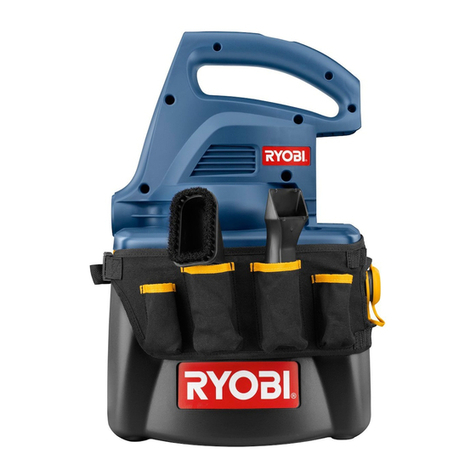
Ryobi
Ryobi P3200 User manual
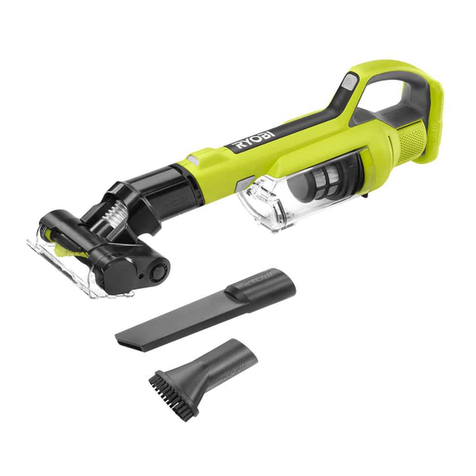
Ryobi
Ryobi PCL700 User manual
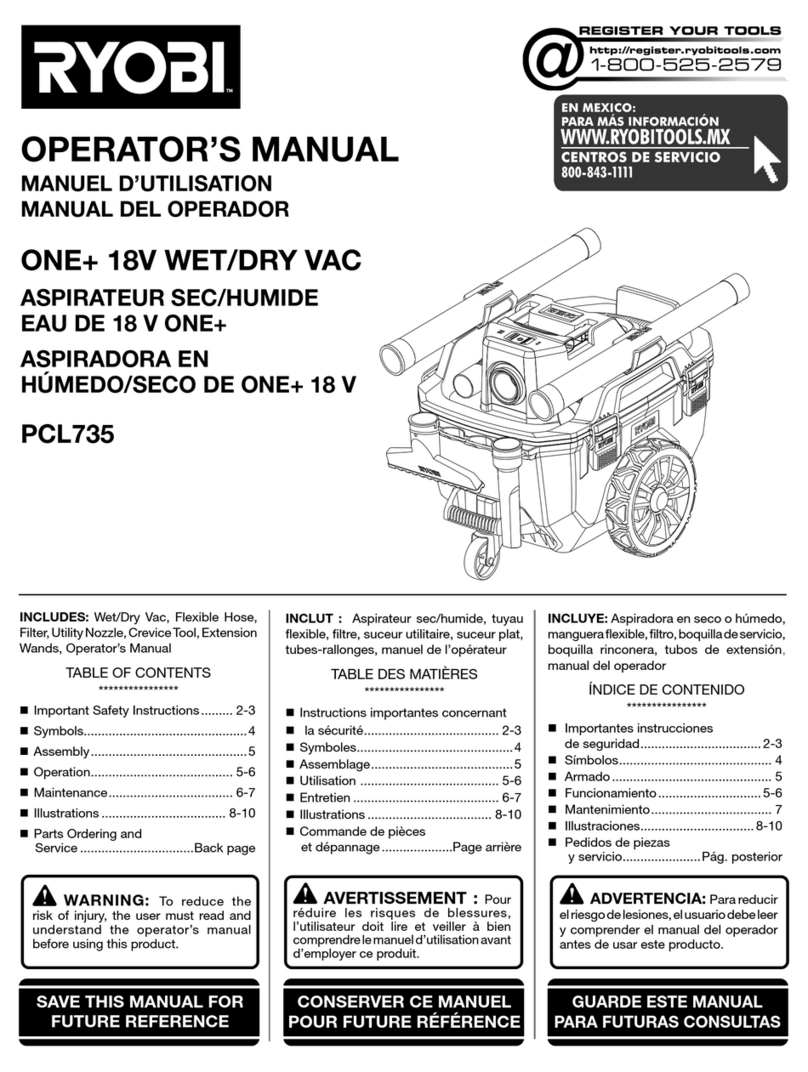
Ryobi
Ryobi ONE+ PCL735 User manual

Ryobi
Ryobi RSC18 User manual

Ryobi
Ryobi R18SV8 User manual

Ryobi
Ryobi RY3112SH User manual
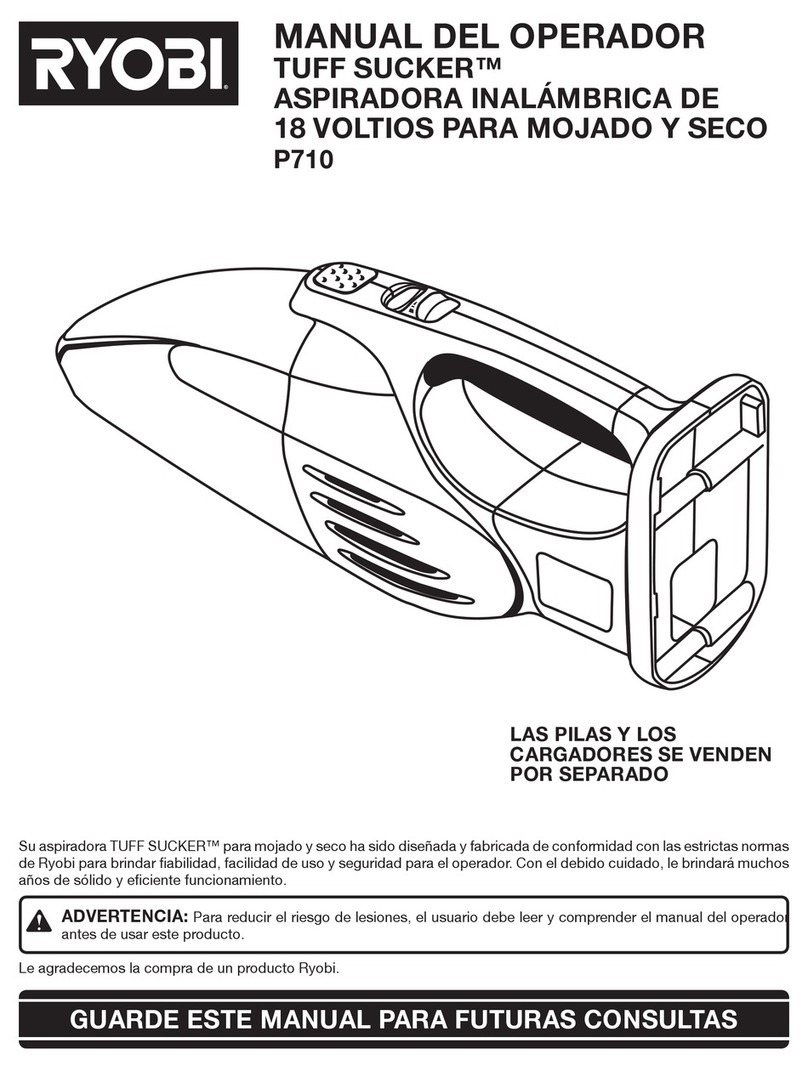
Ryobi
Ryobi TUFF SUCKER P710 User manual

Ryobi
Ryobi CHV182G Operation manual
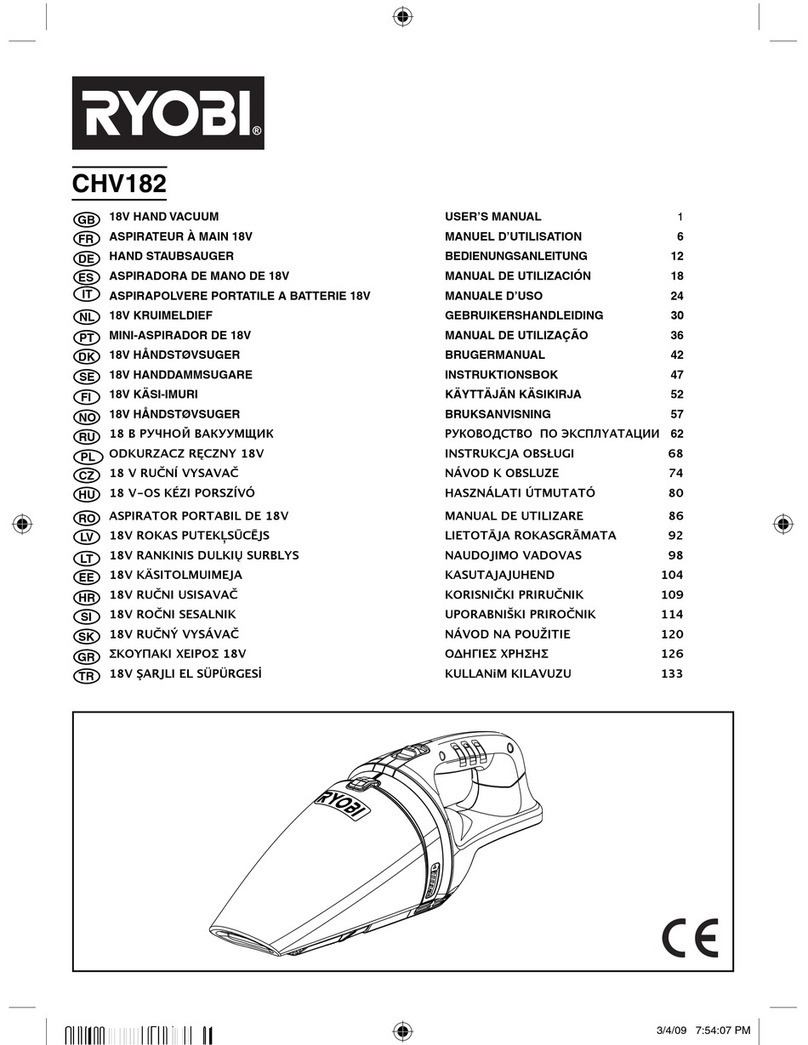
Ryobi
Ryobi CHV182 User manual
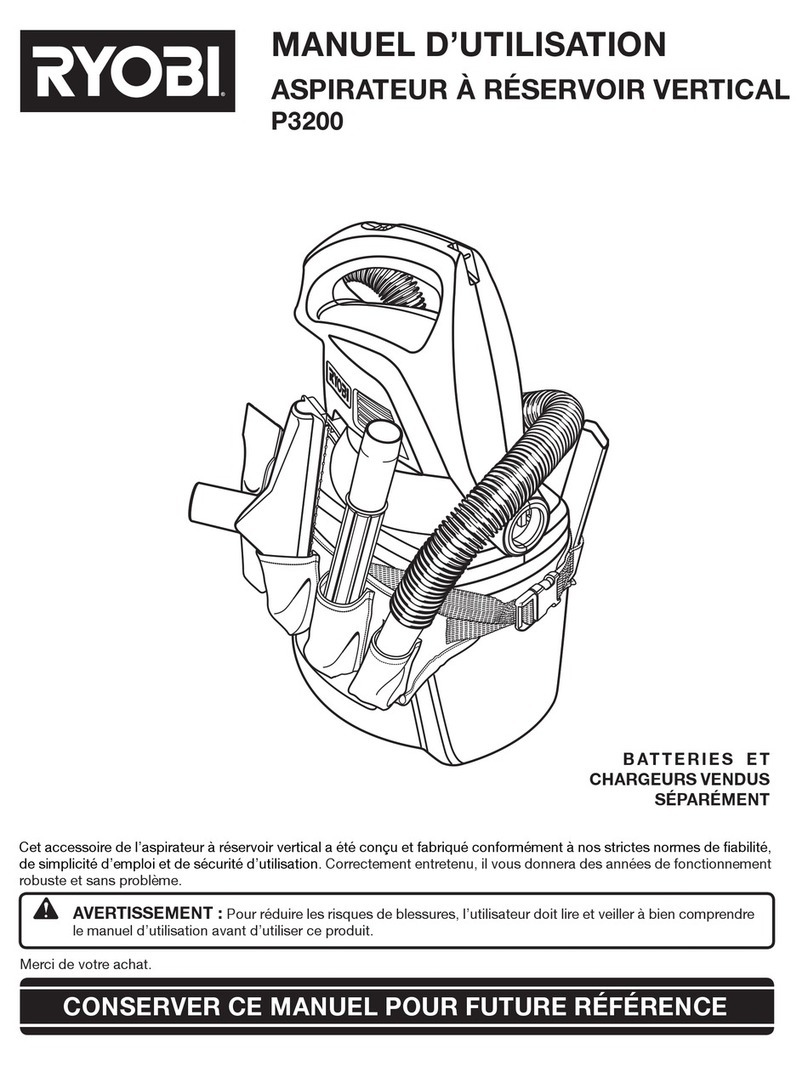
Ryobi
Ryobi P3200 Configuration guide

Ryobi
Ryobi R18XSV9 User manual

Ryobi
Ryobi VC20HDRG Operation manual
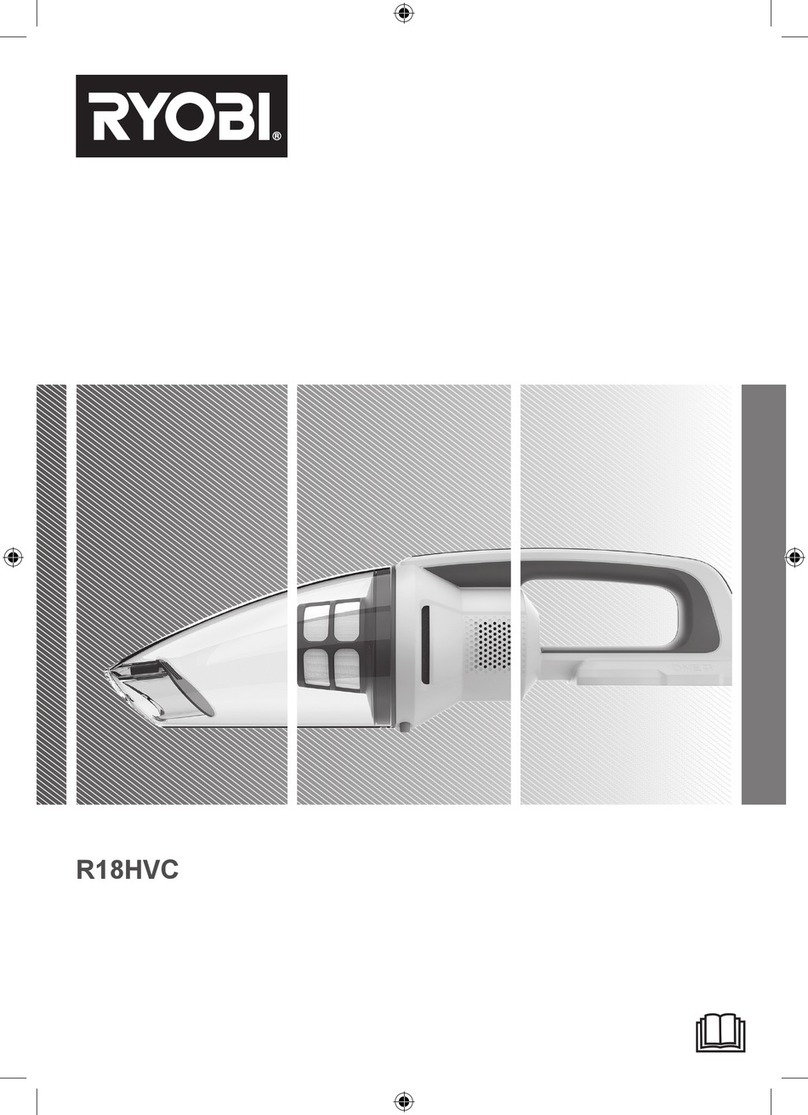
Ryobi
Ryobi R18HVC User manual
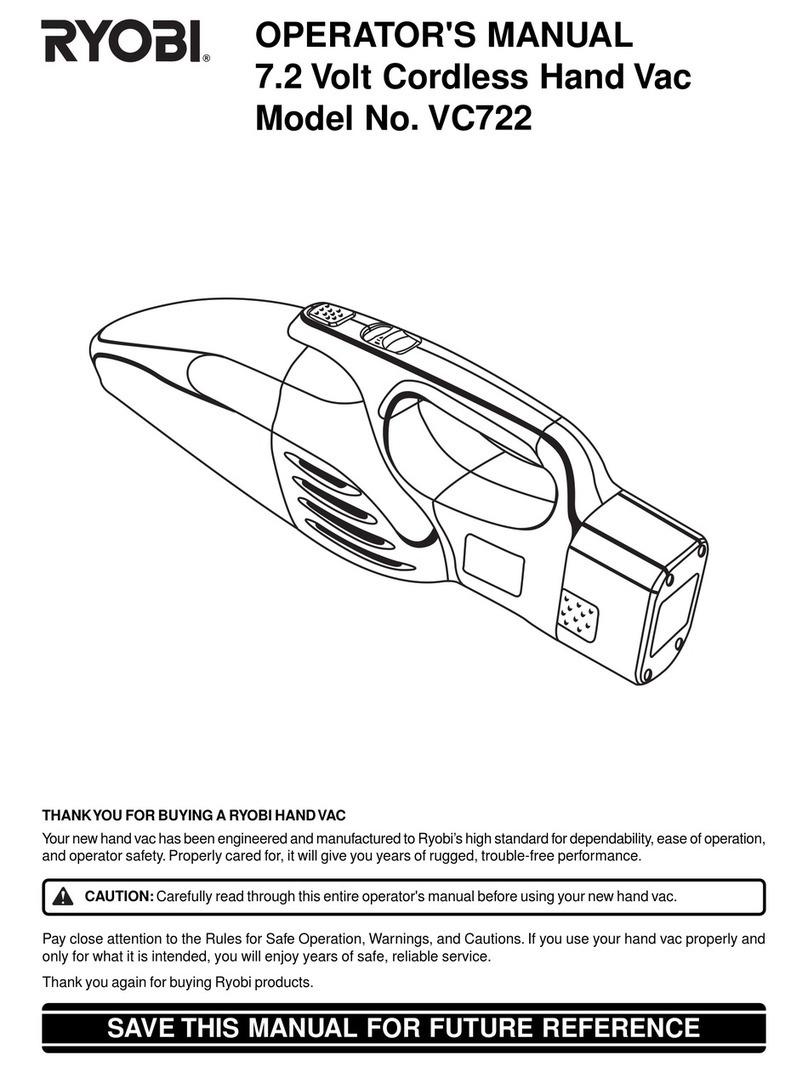
Ryobi
Ryobi VC722 User manual

Ryobi
Ryobi ONE+ P7181 User manual

Ryobi
Ryobi RVC1218P-P Operation manual
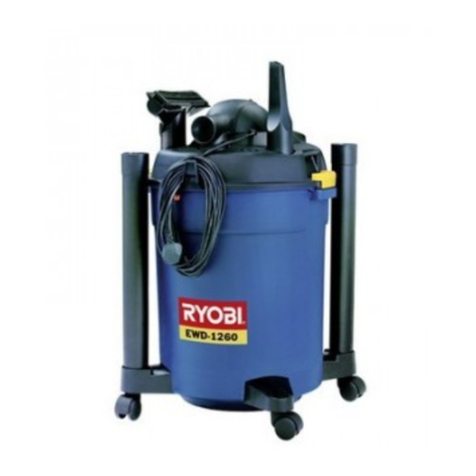
Ryobi
Ryobi EWD1245 User manual
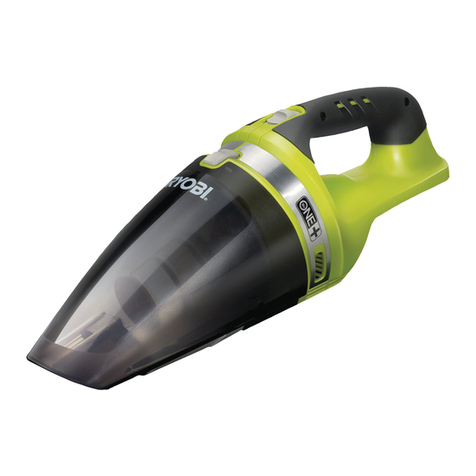
Ryobi
Ryobi CHV182 Operation manual

Ryobi
Ryobi RACWDV40 Operation manual

Ryobi
Ryobi VC20HD Operation manual

